Everything You Need to Know About Taking the Train in France
Enzojz/Getty Images
- Getting Around
- Types of Trains

International Train Services
- How to Buy Tickets
- Tips for Taking the Train
France is the largest country in western Europe, so train travel makes sense. Happily, France has a fast and efficient train system, and the French government has invested massively in high-speed trains (the TGV train or Train a Grande Vitesse ) and high-speed lines (LGV or Ligne a Grande Vitesse) .
There are over 1,056 miles of dedicated high-speed lines and thousands more main lines and smaller lines, so almost everywhere is accessible by train travel in France.
The French rail network links all the major towns and links up many small towns in rural France. With careful planning, you can get around just using train travel during your vacation. Generally, the trains are on time, comfortable and relatively cheap.
However, some trains run only at certain times on certain days, so you need meticulous planning if you are traveling in rural France by train.
Getting Around France From Paris
Like many capital cities, Paris suffers from having no central railway hub, but a number of mainline termini. Here are some of the main destinations served from the main stations .
- Gare du Nord: Northeast France, London (Eurostar) , Brussels, Amsterdam (Thalys), Lille, Valenciennes, Calais
- Gare de l'Est: Nancy, Metz, Reims , Strasbourg , Germany, Luxembourg
- Gare de Lyon: Lyon , Dijon, Besançon, Geneva, Mulhouse, Zurich, Clermont-Ferrand, Marseille , Nice , Nimes, Montpellier , Perpignan; Italy and the east of Spain
- Gare d'Austerlitz: Tours, Poitiers, Limoges, Bordeaux , Toulouse , Biarritz, western Spain
- Gare Montparnasse: All western TGVs, Brittany , Brest, Rennes, Nantes
- Gare St. Lazare: Caen , Cherbourg, Rouen , Le Havre
Types of Trains in France
All types of trains run in France, from the special TGV and other high-speed trains to smaller branch lines. While some lines are operating old carriages, most of the trains are now comfortable, modern, and have high-tech additions like WiFi. Many have massive picture windows along the sides; others have an upper deck that gives you a fantastic view of the French countryside you are powering through.
The main types of trains in France are:
- The TGV Train network ( Train a Grande Vitesse ) runs to major cities in France and Europe.
- Intercites trains cover many of the medium distance routes between cities like Amiens, Orleans, Bordeaux, Caen, Lyon, Reims, Troyes, Toulouse, and Paris. They link cities in French regions like Nantes, Bordeaux, and Lyons-Nantes-Tours.
- TER is the French regional service running from towns and villages over 21 regional networks in France.
- AutoTrain sleeper service runs from Paris Bercy Station down to the south of France, taking you and your car.
Other national rail carriers use TGV train technology in Europe:
- TGV Lyria trains run through France into Switzerland
- Eurostar runs between the UK, Lille, Paris, and Brussels
- Thalys trains run to Belgium, the Netherlands, and Germany
How and Where to Buy Tickets
Like most countries, ticket prices vary widely. If you can book early, you will get good bargains, but you may have to stick to a specific time. If you book that and miss the train, you may not get reimbursed.
Ticket prices are no higher on a TGV or express train than on a local line. And to compete with the low-cost airlines, TGV trains offer reasonable prices for early bookings and for the less popular times of trains. Internet booking is always a good idea.
All French train tickets can also be ordered online, and you can then print them out on your computer as an e-ticket, exactly as the airlines do.
Visitors from the USA can buy online with Rail Europe , and visitors from the U.K. can buy online with Voyages sncf (formerly Rail Europe UK).
Tips for Taking the Train in France
- Arrive early to find out which platform the train goes from. Paris train stations can be quite confusing.
- There might not be good refreshments on the train; check in advance and, if necessary, buy your own snacks/light lunches at the station.
- You will have to validate your ticket. Look for the yellow machines ( ‘compostage de billets’ ) usually just before reaching the platform. Insert your tickets into the slot and retrieve them. Ticket inspectors will check your ticket on the train, and if it is not validated will probably find you.
How to Ride the High-Speed TGV Trains in France
How to Travel From Paris to Montpellier
How to Travel from Paris to Aix-en-Provence by Train, Car, Bus, and Plane
Guide to Major Train Stations in Paris
How to Travel From Paris to Strasbourg by Train, Bus, Car, and Plane
How to Travel from Paris to Colmar by Train, Bus, Car, and Plane
Traveling to Arles by Train, Plane, and Car
Eurostar High Speed Trains Through the Channel Tunnel
What to Do in Lille in Northern France
How to Travel From Zurich to Paris by Train, Bus, Car, and Plane
Traveling by Train in Europe: Where, Why, and How
France Travel Planner for Every Vacation
France Guide: Planning Your Trip
How to Travel From London to Paris by Train, Bus, Plane, and Car
One Week in France: The Ultimate Itinerary
The Top 10 Most Underrated Destinations in France
Get my newsletter plus a FREE guide of DOs & DON'Ts for tourists!
Oui In France
Ultimate guide to train travel in France (plus where to buy tickets so you don’t get scammed!)
France · travel
As an American, when I think about taking a trip somewhere, I first think of flying or driving to my destination. But in France, train travel is actually one of the most popular ways to get from point A to B.
Whether you’re a commuter or looking to go on vacation, France’s railway system is a well-connected and efficient way to travel around France and to other destinations in Europe. Before considering train travel in France, keep reading to learn what you need to know before you go (and where to buy France train tickets)!
Quick guide to train travel in France
Other than commuting to work back in the US, I didn’t have much experience traveling by train. That all changed when I moved to France. From short regional trips to much longer journeys, traveling by train has a lot going for it.
Let’s get into what you need to know before you buy a train ticket in France.
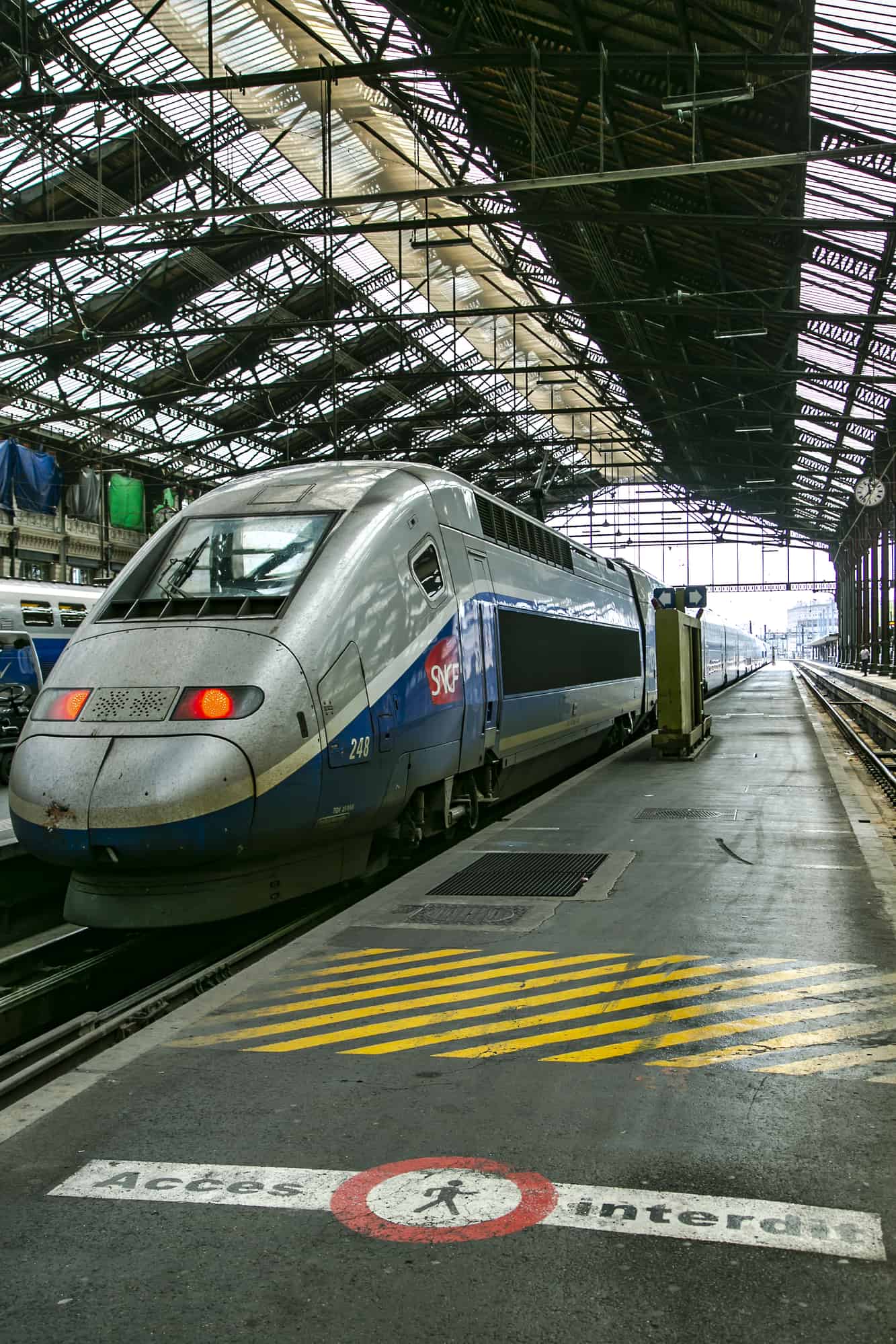
Photo credit: www.depositphotos.com/ursula1964
Table of Contents
Train travel destinations from France
France’s national state-owned railway company is called the SNCF, which stands for Société Nationale des Chemins de Fer Français. The SNCF was founded in 1938, and runs all rail traffic nationwide as well as in Monaco. This also includes TGV (Train à Grande Vitesse) service, the high-speed rail network. France has 27,483 kilometers of railway lines (only second to Germany) making train travel in France a popular option. (via Statista as of 2019).
All of France’s big cities are accessible via train, with Paris being a major hub. In Paris alone, there are six train stations that will get you to other areas of France and Europe: Gare du Nord, Gare de l’Est, Gare de Lyon, Gare d’Austerlitz, Gare Montparnasse, and Gare Saint-Lazare.
In addition to big cities, you can take the train to smaller towns and even more rural areas. Train travel is great for weekend trips from Paris as well. If you’re looking to travel to other areas of Europe via train, you’ve got options. Travel to London, Brussels, Amsterdam and more via SNCF service!
Must-know tips for your first trip to France >>
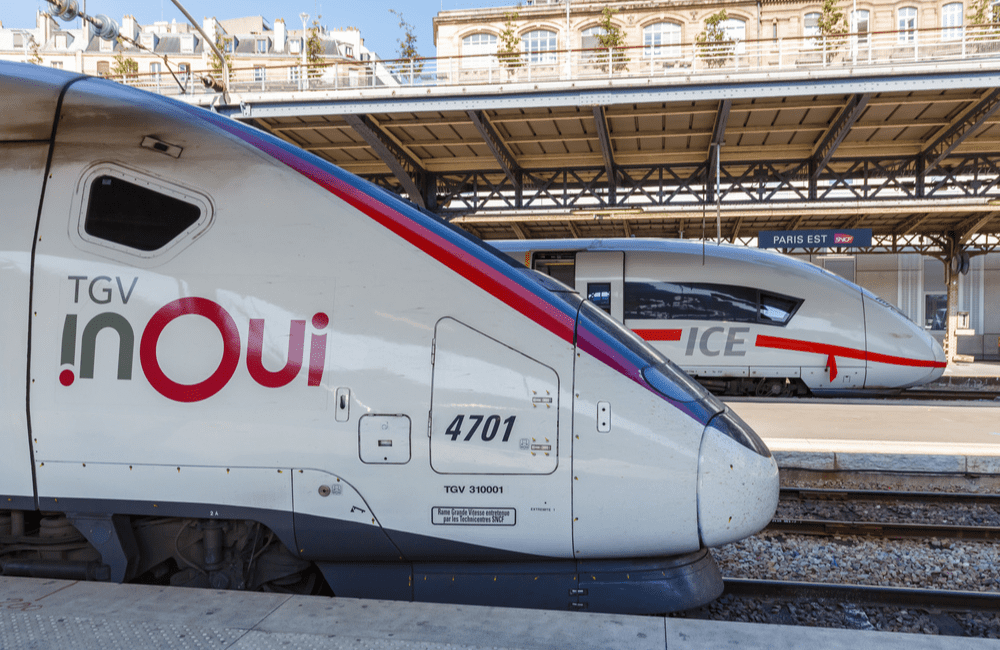
Photo credit: www.depositphotos.com/Boarding2Now
Types of trains and service in France
Train service in France runs like a well-oiled machine with a wide variety of routes nationwide that include big cities, small towns, and even rural areas. As of 2019, the entire SNCF network has over 27,000 kilometers of railway lines, 58% of which were electrified. Over 15,000 commercial trains run daily, transporting more than 5 million passengers and more than 250,000 tons of goods, reported the SNCF.
Let’s talk about the different types of passenger trains available:
TGV INOUI : The TGV is France’s most well-known train, which stands for Train à Grand Vitesse which translates to high-speed train. They can hit speeds of up to 300 km/h (186 mph). The TGV services 200 destinations and has been operating since 1981. TGV Europe also services destinations in Germany, Italy, Spain, Luxembourg, and Belgium. The TGV is the train you take when you want to get from point A to B as quickly as possible.
TGV Lyria : High-speed service that connects France to destinations in Switzerland.
OUIGO: OUIGO is all about low-cost train fares on the TGV. Be sure to book early to score these offers! Small pets travel for free, a piece of luggage is included in the fare, and they’re a steal if your destination is one of the 41 they service. Kids 0-11 years old travel for 5€ one way.
One drawback of OUIGO service is that you have to arrive 30 minutes in advance so staff can check tickets. In addition, extra luggage and seats with a power outlet cost extra and there’s no dining car. Seats tend to be a bit smaller and less comfortable, so take all of that into consideration. None of these were dealbreakers for me when I’ve taken OUIGO trains, though they may be for some people.
As of April 2022, the SNCF launched the OUIGO Train Classique. It is a slower service debuting between Paris and Lyon and Paris and Nantes. The fares are between 10 and 30 euros each way (5€ for kids) and are a great budget-friendly option for those of us who don’t mind a longer trip. The fares are fixed – even for last-minute travel. Note that these fares are only sold online.
INTERCITÉS : Services 150 French destinations, some of which don’t require reservations in advance. They also offer overnight trains on some routes.
TER: France’s regional trains that operate in 11 regions and also connect to the main lines. These are not high-speed trains.
Thalys: High-speed service to Cologne, Amsterdam, and Brussels.
Eurostar : High-speed service to London from Paris, Lille, or Brussels.
Transilien and public transport in the Paris region: This includes the Paris metro and RER trains, bus lines, and more (operated by the RATP). Transilien refers to commuter service in the Paris area.
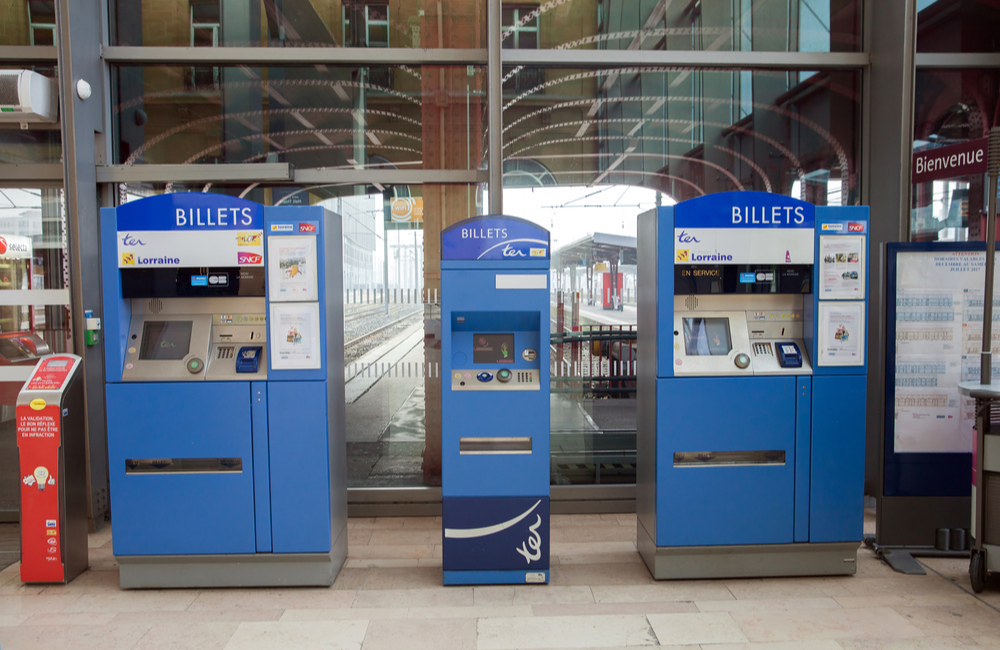
Photo credit: www.depositphotos.com/anrymoscow
Where to buy train tickets in France
You have a couple of options for how to book train tickets in France. You can buy them in person at any train station either at the automated machine terminals or face to face at the ticket window. If you go the ticket window route, take note that they are generally open during French business hours and not 24/7.
Also be aware that there are different types of ticket machines. Some are only for TER train tickets in France, as shown above, and others are for TGV tickets, etc.
Your other option for where to buy train tickets in France is to do so online. This is the only option for many of us if we’re not currently in France. It’s so important to buy from the French SNCF directly to avoid fees and extra hassle. If you do a quick web search for, “How to book train tickets in France,” the official site is often not the first one that comes up and I’ve heard from many of my readers how they’ve been ripped off.
As I mentioned, France’s railway network is called SNCF and the official website/app to buy train tickets is now called SNCF Connect (formerly known as OUI.sncf). The new site has easier route mapping, integrated commuter support and so much more that makes planning a trip a breeze. It’s also available in English.
You can buy tickets for all the types of transport listed above from your computer or phone via their website or the app. You then have the option of printing out a paper ticket or saving the digital version to your phone. The direct website for French train tickets:

There are also other sites called Rail Europe and others geared toward English-speaking foreigners where you can buy France train tickets. They are third-party resellers that are not official sites. Prices are often elevated, so I don’t recommend ever using them. Always go the official route. It’s the best way to buy train tickets in France.
On SNCF Connect , in addition to actually buying/exchanging your France train tickets, you can also plan your trip, find the best door-to-door route, get traffic updates and alerts in real time and buy and renew regional cards and passes. You can also access bus lines and ride sharing offers.
If you travel frequently, are a student, or a senior citizen, it may be cost effective to look into special train passes, so see if you qualify to save a few bucks.
Just like with flights, train ticket prices in France fluctuate as well. You can usually get a much better deal well in advance, while last-minute tickets are usually the most expensive.
BIGGEST MISTAKES tourists make in Paris >>
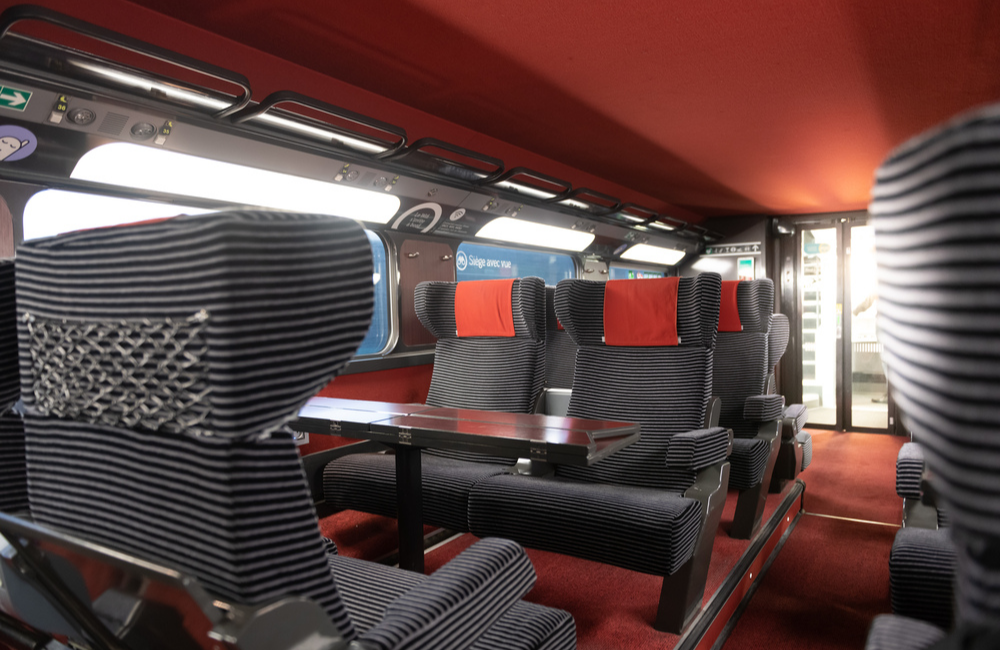
Empty first class TGV seats. Photo credit: www.depositphotos.com/Pixavril
Expert tips for train travel in France
1. Buy tickets early for the best price and availability. If you’re looking to travel by train and know your plans well in advance, it pays to buy the tickets well in advance. You’ll get the best price. Another reason why you’ll want to book early whenever possible is because trains in France sell out since all seating is reserved.
This can be especially true during the peak summer months, during school vacation periods, and on popular routes. As I recommended above, be sure to only use the official site SNCF Connect for the most accurate information and cost-effective tickets.
2. Book a seat that makes sense for you. All TGV seating is reserved. TGVs and longer trips require you to book a specific seat and there are different configurations. Most are two by two and you have the choice of an aisle or window seat. There are also “family” seats called carré (square) which are 4 seats in a two-by-two configuration but facing each other with a table in between (imagine sitting at a 4-person dinner table).
That means two are riding backwards. It can be a little awkward facing a stranger the whole ride. Also, riding backwards isn’t always comfortable for people prone to motion sickness, so pay close attention to what seat you’re choosing.
In addition, some trains are double deckers and have an upstairs level accessible by a staircase. If you have several pieces of luggage or aren’t able to easily climb stairs, upstairs may not be the best option. The booking system will assign you a seat that is easily changed before finalizing your reservation, so again just be sure you’re comfortable with the seat you’re selecting.
3. Consider first class. Along with the above, it might make sense to book a ticket in first class. Sometimes they’re only slightly more expensive than regular second class fares, especially when booked in advance. For more comfortable seats with a little more leg room, more luggage storage, a plug for electronics, and more, first class might be a good choice for business travel or long trips where comfort is important.
Overall, I’ve found that first class seats on the TGV aren’t that different from second class so they aren’t worth a splurge if the difference in fare classes is steep.
4. Show up early. If you’re not used to taking the train in France, be sure to give yourself enough time to navigate the station and get to the right platform and track (called voie in French. You’ll see tracks noted as Voie A, for example).
Paris stations are big and it can be confusing if you’re not used to how things are organized. Spare yourself the added stress that comes along with rushing or having to rebook a missed train and get there on the early side.
5. Note the number of your train car and line up on the platform accordingly. This is a VERY IMPORTANT tip . For trips with reserved seating, it’s imperative that you look closely at your ticket and mentally note the specific train carriage number in which you’ll be seated.
Then find the black display sign on the platform titled “Composition des Trains” that tells you where to stand for your specific car number. It looks like a lit up outline of a train and will usually have a “You are here” dot so you can gauge how far left or right you need to walk to get into position.
TGVs and other international trains can be quite long with 20 or more cars or even two trains that are attached. Because stops are often only a couple of minutes long, you need to be in the vicinity of your assigned seat because you won’t have time to run the length of the platform if you’re near car 4 and yours is actually car 18. This happened to my aunt and uncle in Marseille. They couldn’t get to their train car in time with all their luggage and missed the train.
You can’t just get on and walk between the cars because they aren’t always connected and with the crowds and luggage, it’s not feasible. In some cases, as I mentioned, two separate trains might be connected as they depart Paris but at some point they split and go to different final destinations.
It’s really important you check that you’re in the right seat and in the right car! Definitely take extra care when it comes to lining up ahead of time and then finding your seat once on board.
A final note on the Composition des Trains display sign: There won’t be an employee directing you and it’s not required to line up in any specific place. It’s just that the Composition des Trains display is there for a reason, so be sure to take a look so you aren’t on the opposite side of the platform when the train comes. That way you’ll be in the general vicinity of your assigned seat and won’t have to run.
6. Note the train number. Each train has a specific number so when you look up at the big board or screen in the station that lists out all the departures, you’ll see a train number that corresponds to the destination and time.
Several trains may be going to or coming from the same place so it’s important to know you’re on the train you actually bought a ticket for.
Must-know travel phrases for your France trip (with audio) >>
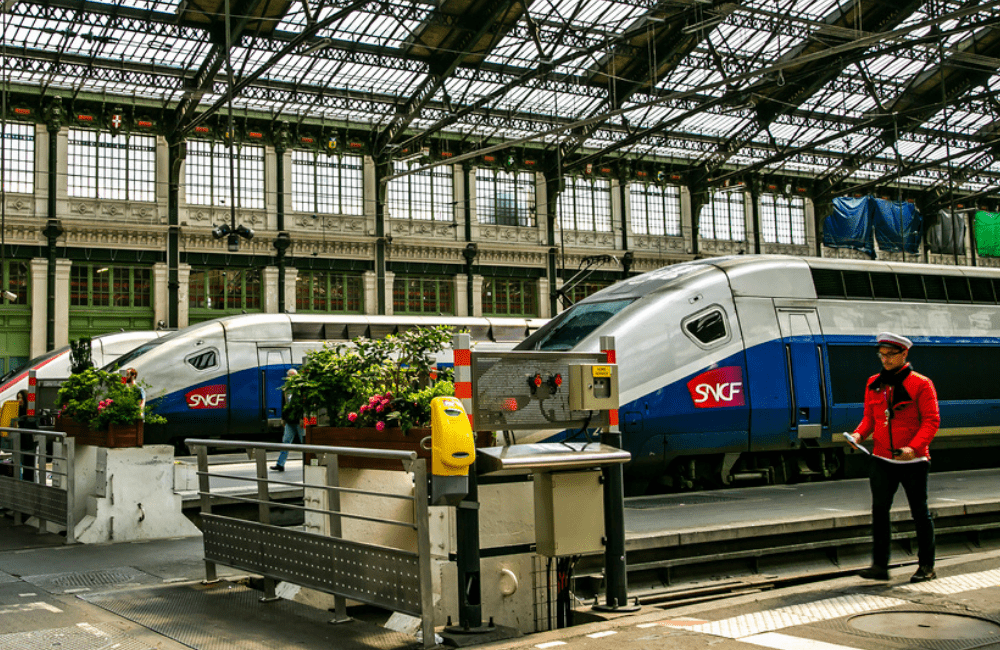
The yellow machine is where you validate your paper ticket prior to boarding. Photo credit: www.depositphotos.com/ursula1964
7. Don’t forget to validate your ticket. All paper tickets for Europe train travel need to be validated before you get on the train in France. To do this, look for the yellow machines with a ticket slot in the train station. There are several usually at the entrance, on the platform, and around the ticket machines and are marked “Compostez votre billet” (validate your ticket).
You insert your ticket into the machine and two seconds later it spits it out with a stamped line of text validating that the ticket is now used. You’ll need to show it to the train employee (contrôleur in French) when he or she checks your ticket after boarding (or in some cases before you board).
Along with that, be sure to have a photo ID with you even for regional trips. In the case of buying your France train ticket online, it’ll be in your name and sometimes they check ID as well. Keep in mind there is no validation process required for e-tickets because they have a special QR code that is scanned directly from your phone. Just the paper ones require the stamp from the yellow machine.
As you’d expect, ID is always checked for TGV and other international trips. Another note on tickets is to always play it safe and buy a train ticket. While the conductor doesn’t always check all tickets, fines are heavy if you try to get a free ride.
Another important tip I should mention is make sure your phone is charged if you have an e-ticket since you’ll need it on and functional to show your ticket.
8. Keep your voice down. Train cars tend to be on the quieter side in France and Europe. People tend to keep their voices low when having private conversations and phone calls are not allowed in some cars. It goes toward respecting the public space and not disturbing those around you. The general attitude for train travel in Europe is to keep your voice down.
American social norms that don’t translate to French cultur e >>
Pros of train travel in France
Easy and efficient way to travel. While France train travel isn’t perfect, it’s a pretty stress-free way to travel. You can easily book your ticket online, arrive at the station, and go. Voilà!
The country is extremely well connected and whether you’re traveling within France or to neighboring European countries, SNCF Connect has you covered. Also, train travel in France doesn’t require you to arrive hours early like air travel does.
Comfortable seats. Compared to regular economy class on most airlines, trains in France are quite comfortable. You have more legroom, big picture windows to take in the view, decent sized bathrooms, and more.
You can head to the bar/food car on some trains where you can buy something to eat or drink. You’re always welcome to bring your own food as well. Many newer trains also have free Wi-Fi.
Lots of options in terms of timing. Most routes have several trains per day (even hourly!) so you have your pick as to whether you leave in the morning or evening or somewhere in between. Train travel is extremely convenient and that’s a top pro.
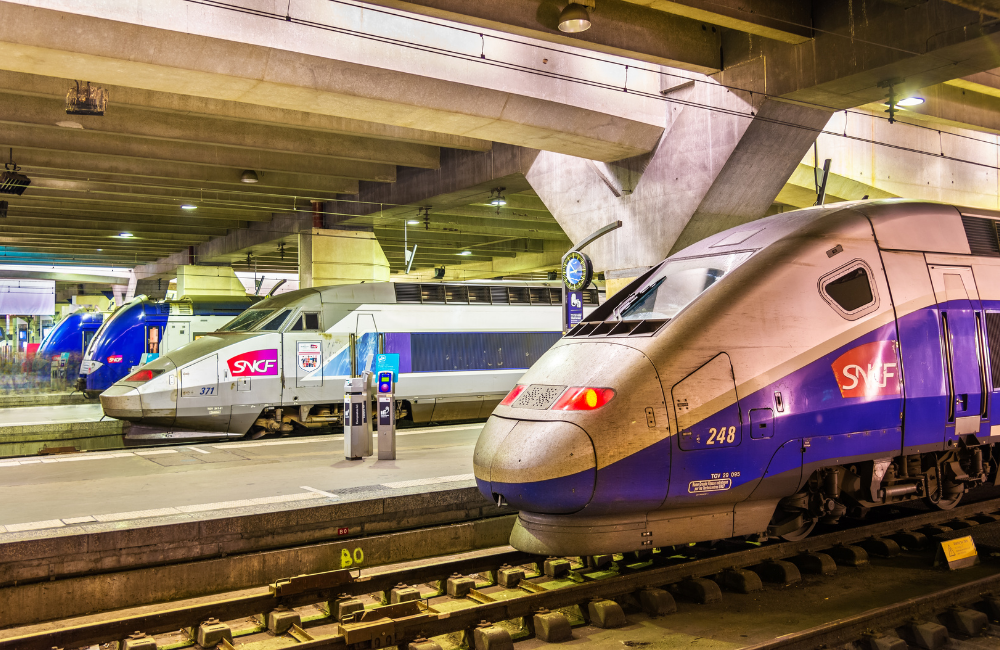
Cons of train travel in France
Possibility of strikes and delays. Like air travel, train travel in France isn’t without its drawbacks. Strikes and delays are not uncommon occurrences. The bright side is strikes are usually announced in advance so you can plan ahead but delays come down to luck.
Weather, technical issues, and more play into whether your trip will be delayed so it just comes with the territory. I take the train regularly and I’m happy to say I’ve only been inconvenienced by strikes and big delays a handful of times in 10 years.
Trips can be long and routing isn’t always direct. If you’re in a rush, train travel may not be for you. TGV and other international high-speed options aside, if you’re trying to get from Angers to Perpignan like I had to when my flight was canceled a couple of years back, be ready for a long day. Routes aren’t always direct and many go through Paris.
In my case I had to change train stations (not just the train!) in Paris which required a taxi. Then my second train was a very slow one that made all the stops. I think the trip was over 8 hours total (flight would have been an hour and 20 minutes).
If you’re in a rush or hate long trips, train travel may not make sense for your specific situation depending on your route.
Not great if you have a lot of luggage. Unlike air travel where you can check large pieces of luggage, when you go by train, you’re responsible for hauling your suitcase(s) onto the train and stowing it in the luggage area. Depending on where you’re seated, this can mean lugging it up or down stairs.
This can be even a bit more challenging on crowded trains when luggage areas are already full. While there aren’t firm luggage limits on regular fare trains, it can get really cumbersome when you have two or three suitcases.
If you are traveling solo and have two or more pieces of luggage, keep in mind that trains only stop for a few minutes so take steps to make the whole on/off process run as smoothly as possible. This includes booking a ticket on the lower level so you can avoid stairs and making sure that you line up on the platform in the area that corresponds to your reserved seat, as we talked about above.
Also, when it’s time to get off, start getting your suitcase out of the luggage area a few minutes before the train arrives in the station. People who got on after you might have boxed your suitcase in so leave yourself time to get organized.
Have you taken a French train? How was the experience? I hope my guide to train travel in France was helpful! Buy your French train tickets and bon voyage!
Traveling to France soon and want to be prepared? Check out my eGuide titled “ 75 Beginner France travel tips for a standout trip! ”
Need some tips on how to dress like a French woman? This is my no BS guide on how to dress in France .
Disclosure: This is a sponsored collaboration between SNCF Connect and Oui In France. All opinions are my own.
PIN my France train tickets and French train travel post:
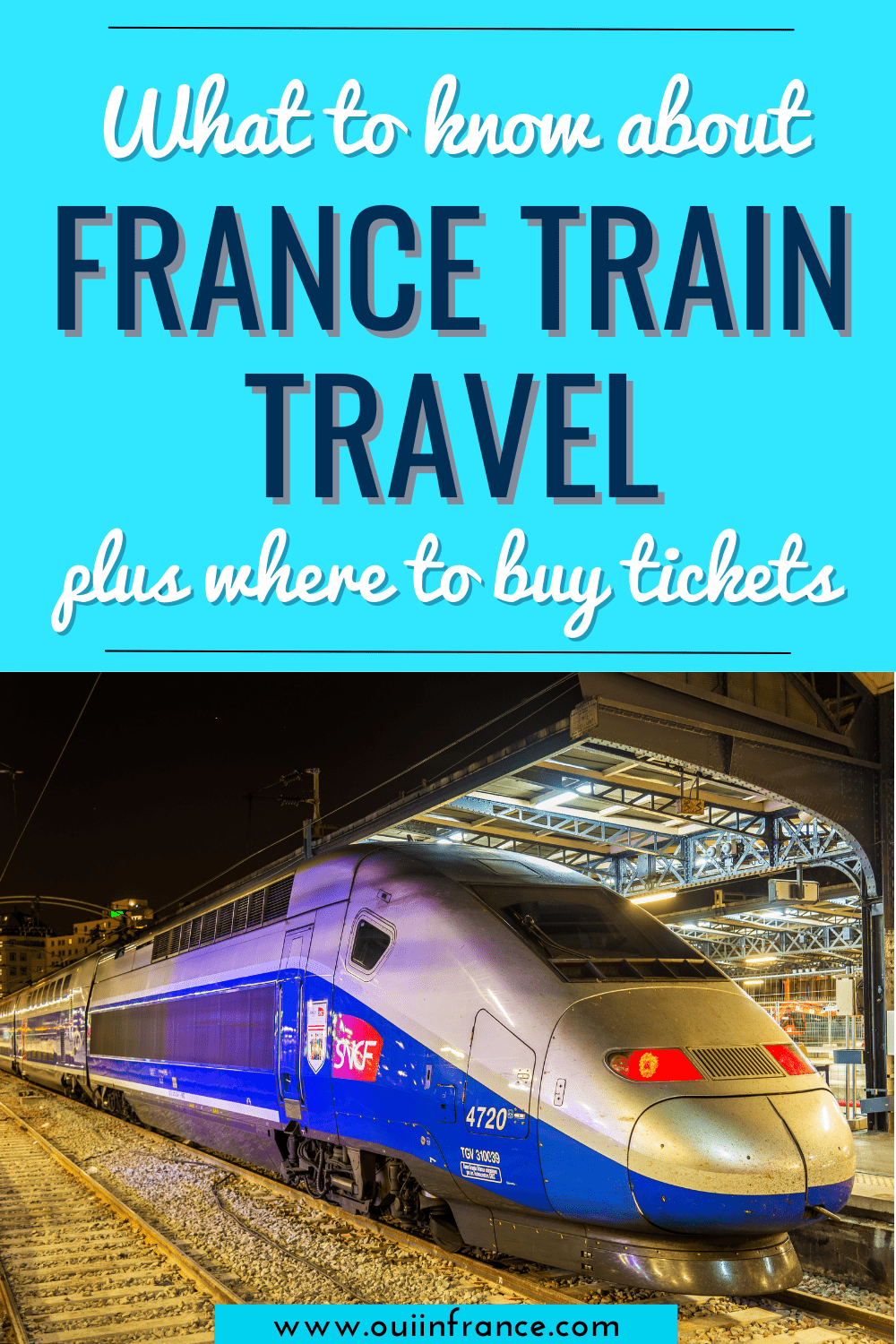
You might like
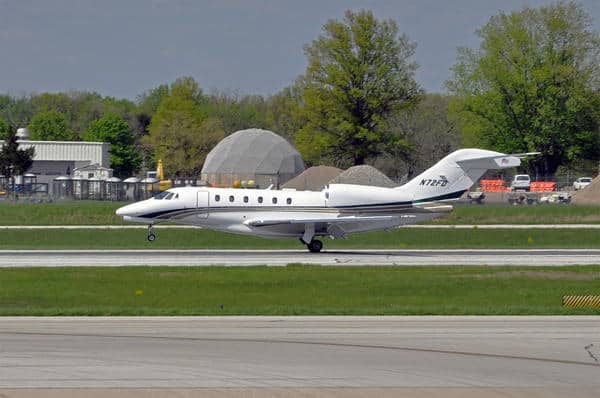
Sign up for the Oui In France Newsletter!
Stay up to date with everything Oui In France! Plus get my FREE GUIDE with 24 DOs & DON'Ts to keep in mind when visiting France!
April 22, 2022 at 5:34 pm
Hey Diane, Great article! Good timing as I’m on a Thalys heading Paris-Amsterdam. I have a question about seats. I did switch seats online when I bought them but I’m stumped as how to make sure I’m not sitting backwards. There’s nothing on the seat map that shows if you’re going the correct direction of train or backwards. Am I missing something? Thanks and be well!
April 23, 2022 at 11:32 am
I’ve been traveling a lot by train in France for the last 2 weeks mostly using the SNCF connect app. The TER tickets I’ve bought with the app are only available on your phone. You can’t print them. The OUIGO and inOui tickets are on the app and sent as PDFs by email so they can be printed if you have access to a printer. The OUIGO tickets can’t be printed at the station if you bought them using the app. The only downside I’ve found is that scanning the tickets is sometimes necessary to get to the platform and it doesn’t always work from the phone. I and a lot of other people had to get assistance from an SNCF employee. That employee was very helpful but only spoke French. Overall I think the app works very well.
If you’re over 60 and book the tickets more than a day in advance you get a 10% discount even without buying a loyalty card.
April 23, 2022 at 2:54 pm
When traveling via TGV, is there a way to tell which end of your car has the luggage racks? We were a group of 7 in December and sometimes boarded on the end opposite the racks. That made life a little challenging! Also, when booking three sets of TGV tickets for 7, I couldn’t get SNCF to register me. It said I had created an account and would receive an email but nothing ever arrived! Therefore, I couldn’t look up my account to see my tickets. Luckily I had the confirmation numbers and could find them that way. A little frustrating. But the train travel itself was wonderful! We did Paris-Reims-Strasbourg-CDG.
April 24, 2022 at 1:48 pm
Hi ! Racks for luggage can be at several places. It depends if your train is TGV, a TER ou another type of train. In TGV (INOUi and OUIGO), racks are most of the time at both end of the seated areas and in the middle of them. You can also slide under your seat your luggage if it’s not too big.
April 23, 2022 at 6:25 pm
Nice article. I always use trains in Europe, as they are faster than using an airplane. I tried to take your advice and tried to sign up for sncfconnect. After entering my credentials, I received an email that says click on Activate my account. Upon doing so, I received
Unauthorized url: https://www.sncf-connect.com/app/en-ww/account/activation , for application: ccl
Upon replying to the email asking for assistance, it was returned as Undeliverable.
Using the Chat feature on the website got me a See our FAQ.
I’ve always used Rail Europe for tickets. While they may be a touch more expensive, at least you can reach a real person if there’s a problem or issue.
April 24, 2022 at 8:40 pm
Now this was really interesting , I love train travel just don’t have a reason to take a train anywhere.
April 29, 2022 at 11:42 pm
Great article. I wished there were more photos of things you talked about. I found it hard to find the right car (several years ago so maybe the signage has changed) and when I asked an employee, he was less than helpful, a bit irritated (it wasn’t because of my French; I’m bilingual). I had a hard time finding the right car. Also is the lining up new? I don’t remember having to line up for my car by a sign. I would love to see that photo. Anyway, great practical advice. And safe travels to you and your family. Looking forward to reading about it when you return
April 30, 2022 at 5:55 am
Hi Jacqueline, thanks so much! Glad you enjoyed it! Sorry for any confusion about the composition du train display. It’s not required that you line up anywhere and there isn’t an employee who will direct people to the right spot on the track. It’s just there to help people get to the right spot more or less so they aren’t on the opposite side of the platform when the train comes (thus increasing the chance of missing their train). It was just my tip to take a peek at the display to get close to the spot where your particular car will come to a stop? Does that make sense? I will update the post with a line clarifying that (and add a pic of the display after I next take the TGV). Thx again & bon week-end !
June 8, 2022 at 6:49 pm
This was an awesome guide to the French trains and systems. I will save it for when we get to go for a few months, maybe next spring. Thanks so much for this and other blogs and videos that you do. They are helpful for us who plan on visiting in the future as well as those there. One question I have is about pets…I think I have read that you can take dogs on the trains except for the TGV high speed. We will have our little 14lb papiillon with us when we travel, so will need to plan accordingly.
July 23, 2022 at 9:54 pm
Thank you for this article, I found it quite useful. Do you happen to know, if I pre-purchase TER tickets on the SNCF Connect app, am I able to retrieve them while offline? Or would a screenshot do the trick? I will not have cellular access while travelling in Europe (just wi-fi at my destination), and I want to be sure that I can show the conductor my ticket when he/she comes around 🙂
Leave a Reply Cancel reply
Your email address will not be published. Required fields are marked *
Notify me of new posts by email.

As an Amazon Associate I earn from qualifying purchases.

Get our Rail Planner app
Plan your trip, get extra discounts, and show your Pass as you go.

Our favorite spring routes
Celebrate spring with these 7 off-the-beaten-path train routes

All about seat reservations
Everything you need to know about booking your seats

Alternatives to Busy Routes
Travel between popular European cities without seat reservations

Through our Chatbot in the bottom right corner.

Ask the Community
Browse questions from fellow Eurail travellers, or ask your own!
- Plan your trip
- Suggested Itineraries
France Itinerary
- Order overview
- Reservations overview
- My Trips & Travelers
- {{translatedTraveler}} {{#promotional}} {{currencySign}} {{standardPrice}} {{/promotional}} {{quantity}}x {{currencySign}} {{finalPrice}}
- Child {{childPasses}}x FREE
- {{translatedPassType}}
- {{translatedValidityPeriodDescription}}
- {{translatedClass}}
- Remove Pass(es)
- {{variant.localizedTravelPackDescription}} {{quantity}}x Free
- {{variant.localizedPassUpgradeDescription}} {{quantity}}x {{currency}} {{price}}
- Your order will arrive by {{expectedDeliveryDate}} 1 x {{currency}} {{price}}
Your cart is empty
Discover the best of French life with this spectacular France itinerary. Start your trip in beautiful Paris and let the train carry you down to the sunny Mediterranean, while cruising through hillside vineyards and endless lavender fields. Reserve a seat on France's TGV high-speed train for fast and comfortable journeys between major cities. Or take it easy and explore the French countryside with RET regional trains, one charming village at a time. When traveling with a Eurail Pass , you simply can't miss out on la belle France .
Itinerary in short
Cities visited in this trip:.
Click here or on the map to view this route in our Trip Planner.
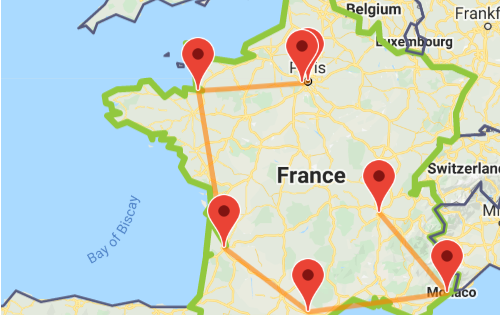
For this itinerary we recommend:
- Eurail pass: France
- Travel days: 7 days within 1 month
Most of the high-speed trains in France, like the TGV and some InterCités, require reservations. These reservations are not included in your Eurail Pass. Make sure to book your seats in advance, there are limited seats available for Eurail Pass holders. It's also possible to avoid reservations all together, simply by taking regional trains .
Travelling to France or Italy with a Eurail Pass?
Let us help you get more out of your trip. Sign up to get discounts and insider tips for your destination , including top attractions, local food and drink experiences and more – all delivered straight to your inbox. Just tell us when your trip starts.
Paris, France
Paris is known as the city of love, and what a lovely place it is! Take a stroll underneath the famous Eiffel Tower and have a glass of wine on the banks of the Seine river. You can do some fancy shopping on the Champs Élysées by day and visit the magnificent Paris Opera by night. The city is a haven for culture vultures, who could spend days exploring the wonderful collection of the Louvre museum . Make sure to visit the art district of Montmartre , where famous painters like Picasso, Dalí, and Van Gogh used to work. Here you'll also find the pristine white Sacré-Coeur Basilica , the second most famous church in Paris, after the hunchback's hideout - the Notre Dame .
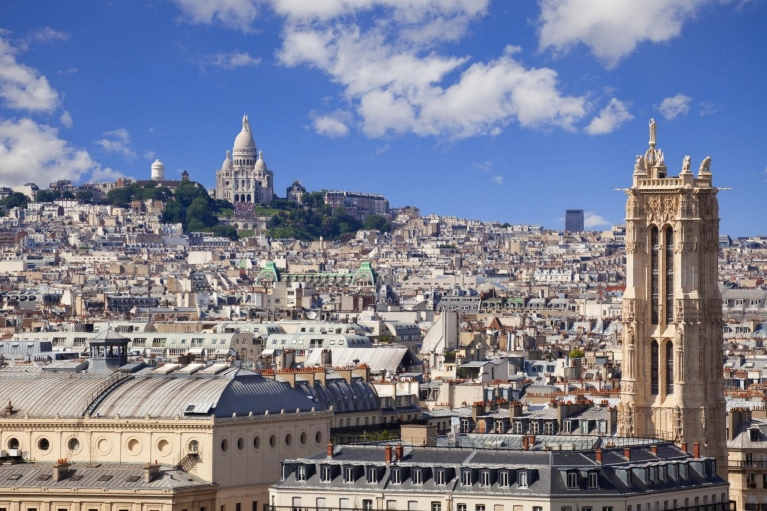
From Paris to Versailles
Travel time:
Gare Montparnasse
Versailles, France
Versailles-Chantiers
For splendor with a capital S, visit the magnificent Palace of Versailles . A symbol of flamboyance, it was the royal palace for two centuries right up to the French Revolution. Take a stroll around the Versailles Gardens to follow in the footsteps of Louis XIV, the infamous Sun King. Inside the palace, you’ll find extravagance in every room. Don’t miss out on the Royal Apartments and the fabulous Mirror Hall (Galerie des Glaces). Visit the Hall of the Battles (Galerie des Batailles) to see France’s military history in paintings and in sculptures.
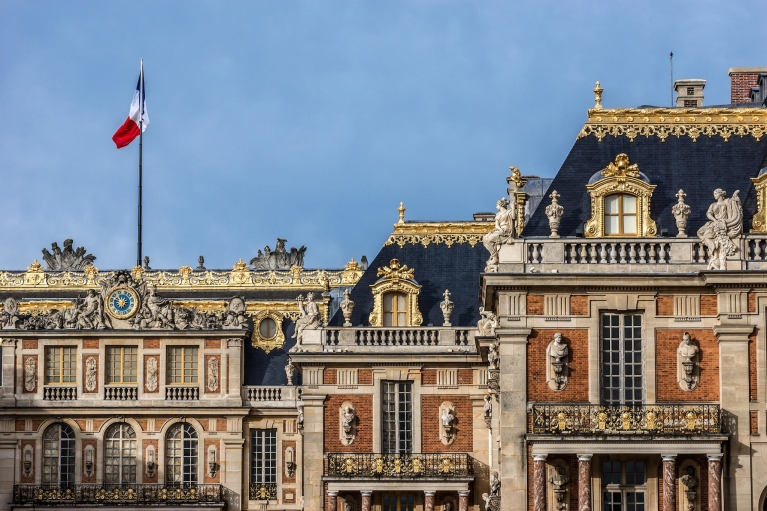
From Paris to Mont St. Michel
Reservation needed:
Reservation required
Rennes, France
Gare de Rennes
Mont St. Michel, France
Mont St. Michel
Mont Saint-Michel, France
An hour out of Rennes, just off the coast of Normandy, you'll find the tiny island of Mont Saint-Michel. It is dominated by the monastery from which it draws its name and was an important place of pilgrimage in medieval times. These days, Mont Saint-Michel is one of the major tourist attractions in France. For centuries, you could only reach the island when the tide was low, but these days a bridge connects the town to the mainland. Take a regional train from Rennes to get to Mont Saint-Michel.

From Mont St. Michel to Bordeaux
Nantes, france.
Gare de Nantes
Bordeaux, France
Gare de Bordeaux-St. Jean
The port city of Bordeaux is France’s uncontested wine capital. You’ll find many luscious vineyards and charming chateaux in the region, which have been producing wine since Roman times. If you're interested in a wine tour , by foot or by bike, beautiful Bordeaux is the perfect place for it! The city itself is rich in architectural highlights from all periods. Climb to the top of the bell tower next to Bordeaux Cathedral (Cathédrale Saint-André) for a stunning view of the city. In the Musee des Beaux-Arts de Bordeaux you can find a large collection of masterpieces by famous European painters.
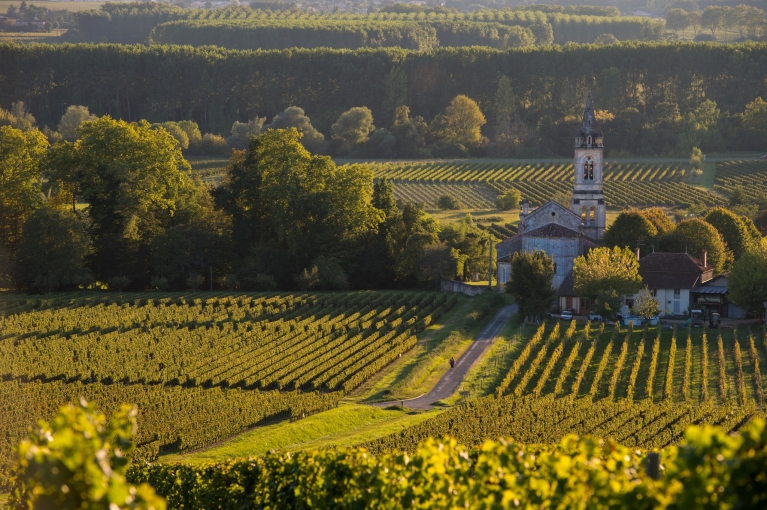
From Bordeaux to Carcassonne
Carcassonne, france.
Gare de Carcassonne
On your way to the sunny Mediterranean, hop off the train in Carcassonne for a sight you'll never forget. The town's medieval citadel will make you believe you’ve stepped out of a time machine. Take a walk through history and visit the Chateau Comtal and the gothic Basilica of Saint-Nazaire . Stand in front of the impressive Narbonne Gate where the centuries look down upon you.
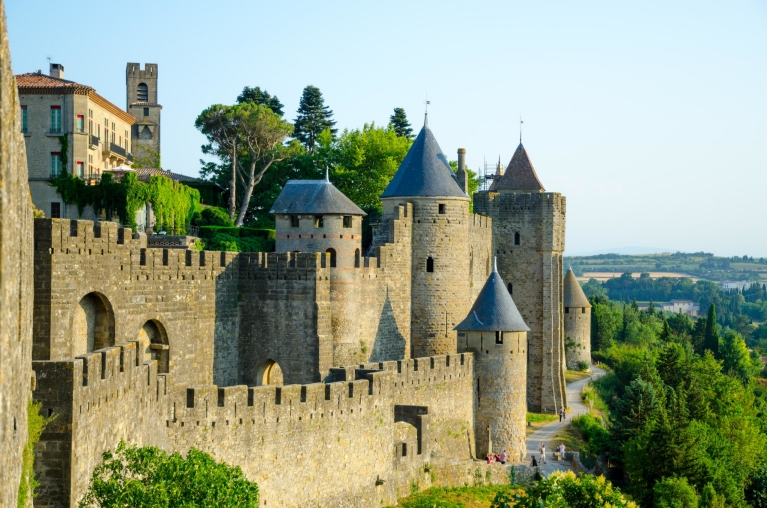
From Carcassonne to Nice
Marseille, france.
Gare de Marseille-Saint-Charles
Nice, France
The city of Nice is located on the Mediterranean coast near the Italian border. It’s one of the most popular tourist cities in France, second only to Paris. Enjoy the gentle sea breeze on the Promenade des Anglais and work on your tan on Nice’s beautiful beaches. Only twenty minutes away from Nice you’ll find the tiny city-state of Monaco . Take a daytrip there to see the yachts in the marina and the Lamborghinis in the streets. If you’re feeling lucky, you can place a bet at the famous Monte Carlo casino.
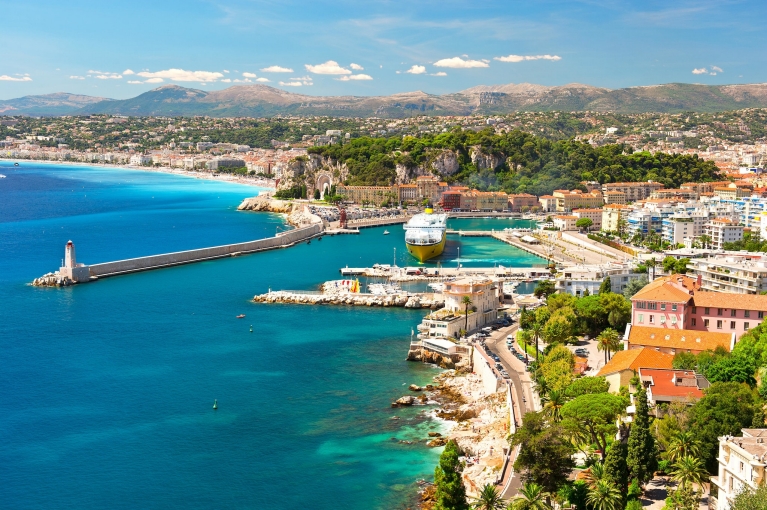
From Nice to Lyon
Avignon, france.
Gare d’Avignon Centre
Lyon, France
Lyon Part-Dieu
If you’re making your way back to Paris, the city of Lyon is the perfect stopover. For centuries now, Lyon has been known as the gastronomical capital of France. Go to a bouchon , a typical Lyonnais restaurant, to taste authentic local cuisine and have a glass of Beaujolais wine. In Lyon's bustling center, you’ll find plenty of interesting sights. Have a look inside the Basilica of Notre-Dame de Fourvière and observe the city from the top of Fourviere hill. If you’re looking for some peace and quiet, visit the Parc de la Tete d’Or , one of the most beautiful parks in France.
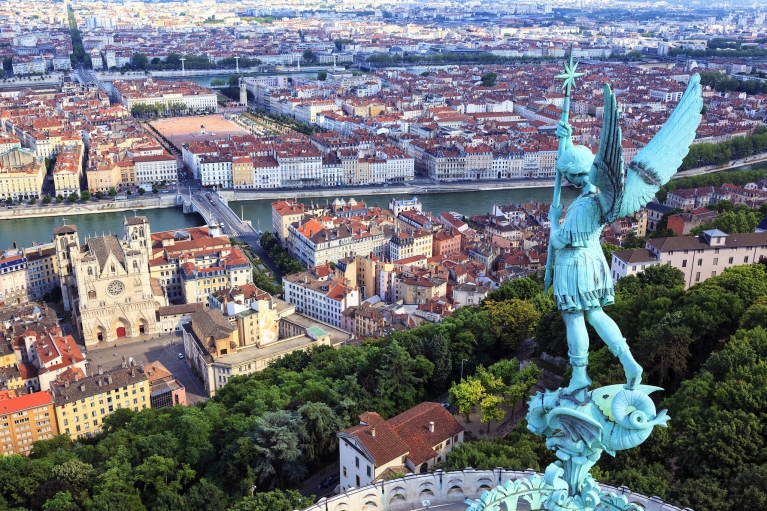
Experience France with the Eurail France Pass!
Change of currency.
You cannot change the currency once you have a Pass in your cart. Remove the Pass, and then change the currency on the website header.
France by Train Itinerary – 6 Ways to Spend 2 Weeks in France by Train
Article written by Elisa - Travel Writer & Local in France This article may contain compensated links. Please read disclaimer for more info.
2 Weeks in France Itinerary by Train – Where to Go?
So you’ve got a trip planned for two weeks in France . Now what? Trying to decide how to visit France in 2 weeks isn’t an easy task. After all, there are so many beautiful places to see that it’s impossible to cover everything in 2 weeks in France.
That being said, you can have a fantastic trip to France and travel back home with the feeling you had a great taste of France.
But where to go? We’ve broken down six ways to spend 2 weeks in France by train, visiting different geographical areas and French regions with no rush. Starting from Paris , CDG Airport , or Nice , and traveling only by train, choose that France itinerary 14 days that tempts you most.
READ MORE – How to Plan a Trip to France
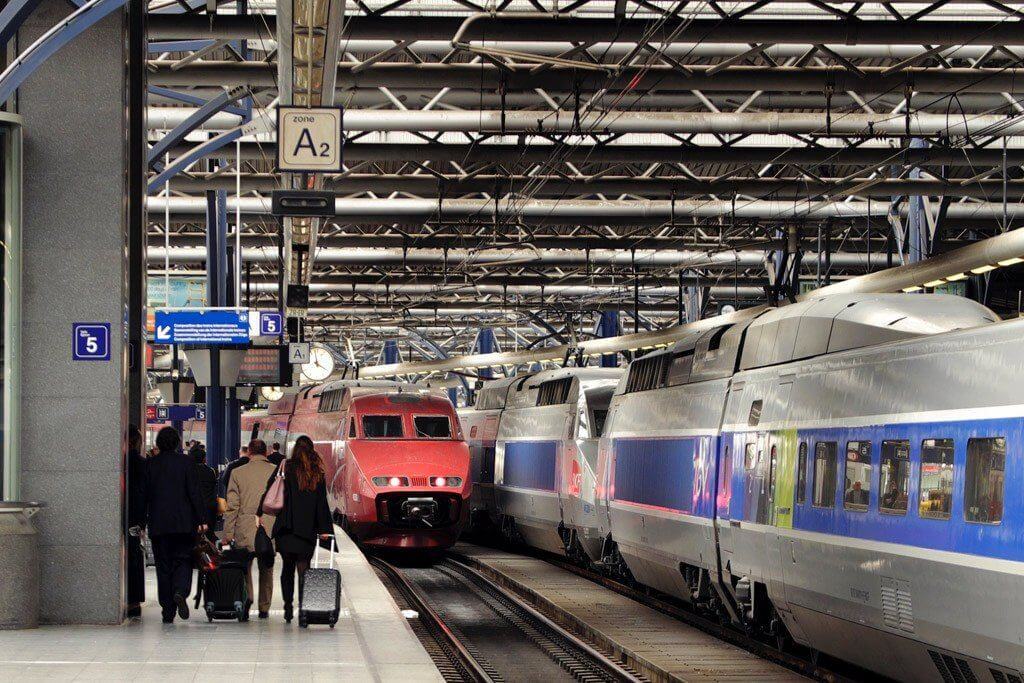
Touring France by Train – Itinerary and Tips
All these proposals are by train, with direct train connections most of the time. French trains are a fun and easy way to visit the country, you can read more in our quick guide to France by train .
Make sure you book the train tickets between the main stops online well in advance: TGV train connections between the main cities sold out fast! For your convenience, we’ve added links to our favorite trusty providers so you can book the train tickets directly from this post.
Most of the itineraries described below start from Paris. You can travel to Paris by train from many European cities in Germany, the UK, Catalonia, the Netherlands, Belgium, Luxembourg, and Italy. If you are traveling to France from overseas, use this link to book your flight tickets to Paris .
And don’t leave home without travel insurance. SafetyWing , our trusted travel insurance policy for long and short trips, covers COVID-19 for new policies purchased, and since April 2021, unplanned quarantine is covered, too. Click here for more info and pricing .
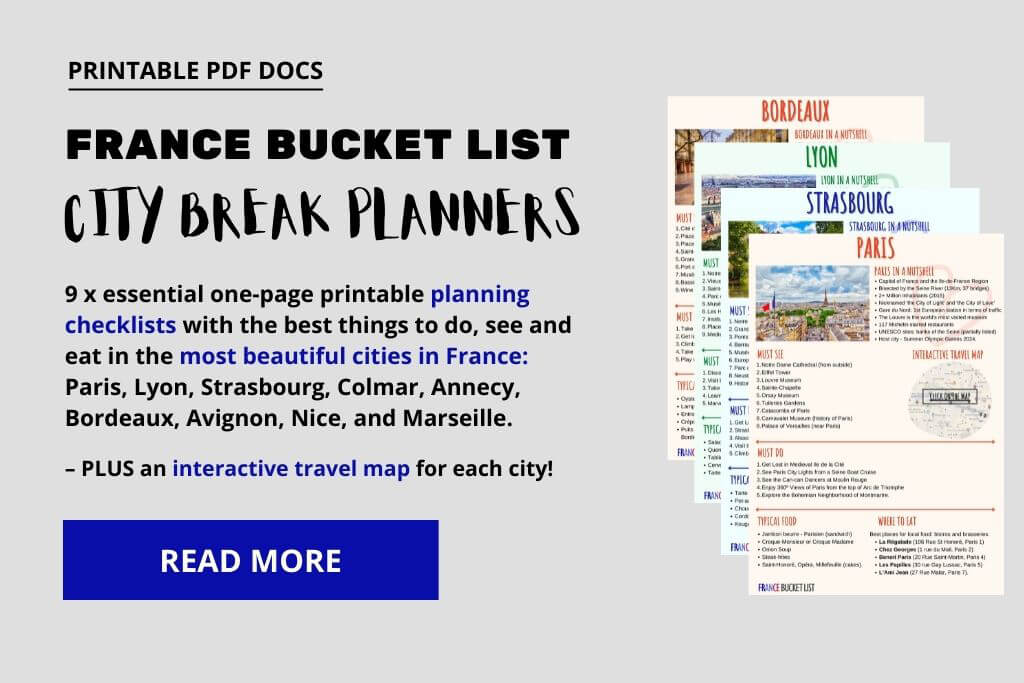
2 Weeks in France by Train Itinerary #1: Paris – Avignon – Marseille – Nice
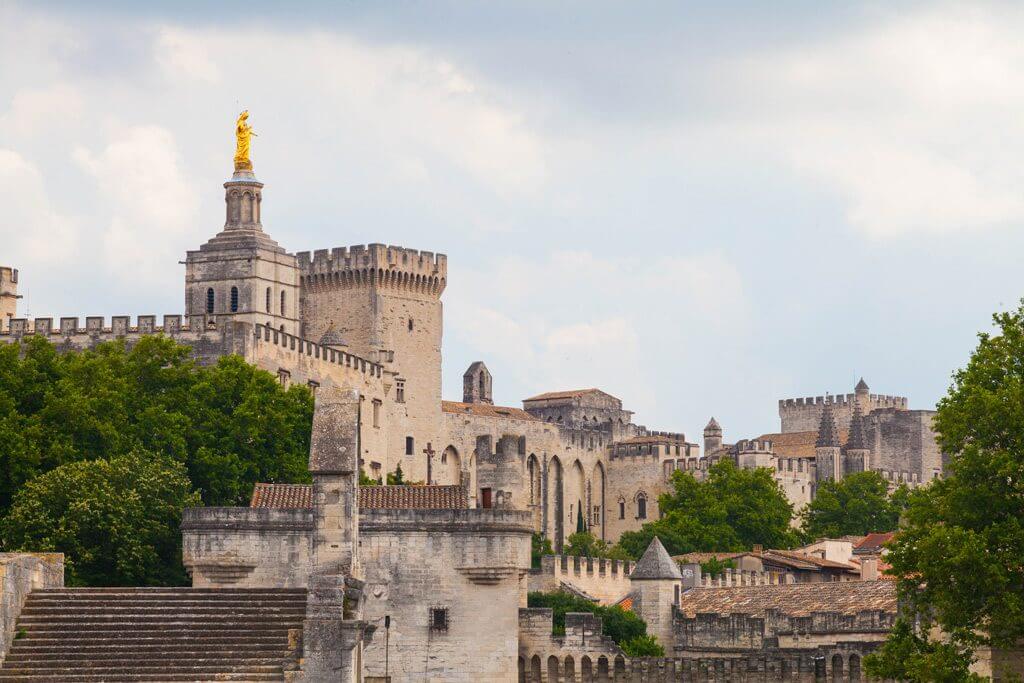
This 2 weeks in France by train itinerary explores the French capital and some of the best places in Provence and the French Riviera in Southern France.
Stop 1 | Paris (4 days)
Paris is a city that really needs no introduction. During your time in the French capital, you will want to visit some of the city’s main sights – perhaps with a couple of leisure strolls around the most picturesque areas – and a day trip to Versailles . If you need some inspiration on things to see and do, this 4-day Paris itinerary will be helpful.
If you count on visiting many museums and Paris landmarks, consider purchasing the Paris Museum Pass for 2 or 4 days . Château de Versailles and the Trianons are included in this Paris Museum Pass.
For your stay in Paris, book at the Hotel Ducs de Bourgogne . Located just 500 meters from the Louvre Museum, this hotel offers its guests great facilities and always gets the best reviews.
Paris highlights:
- Louvre Museum
- Eiffel Tower
- Cruise on the Seine River
- Medieval Ile de la Cité
- Best things to do in Paris
For your day trip to Versailles , check out this Versailles guide , with all the information and our best tips to visit the Versailles Palace, Gardens, and more.
Stop 2 | Avignon (3 days)
Avignon’s main station is Avignon TGV , and it is well connected to Paris by TGV trains. Count on it taking 2 hrs 45 min from Paris Gare de Lyon train station. From Avignon TGV train station, there’s a train shuttle that takes you to Gare d’Avignon-Centre, in the city center, in only 5 minutes.
Click here to book your train tickets to Avignon
After your time in Paris, board one of the first trains to Avignon for a different taste of France. Located in the South Bank of the Rhône River, Avignon was, for a brief moment in time, the center of the Catholic world, as the popes left Rome and came to live in this city. The Papal Palace , built in Gothic style, is a Unesco World Heritage Site and a must-see of Avignon.
In Avignon, Hotel Central has a great and central location near the train station, and it comes with a pleasant front garden and an on-site bar. For something really special, check out Hotel Cloitre Saint Louis Avignon . This hotel is set in a 16th-century building featuring arches and vaulted ceilings, and it has a beautiful garden and an outdoor swimming pool.
Enjoy one day in Avignon . Here everything is within walking distance, and you can easily explore the city while strolling through its small cobblestone lanes. Be sure to visit the Papal Palace and walk through the Pont d’Avignon (the famous bridge) or at least admire it from afar.
Use the second day in Avignon to explore the Luberon . During the lavender season in Provence , take this top-rated lavender tour that includes the 12th-century Senanque Abbey and its surrounding lavender fields , plus the oh-so-pretty village of Roussillon .
Out of this period, we recommend this Best of Provence tour that takes you to the Roman aqueduct of Pont du Gard and some of the most beautiful villages of Provence .
Stop 3 | Marseille (3 days)
Marseille’s main station is Marseille St Charles , and it is well connected to Avignon by TGV trains. Count on it taking 35 min from Avignon TGV train station.
Click here to book your train tickets to Marseille
Marseille is the capital of Provence, a vibrant port city with a strong character and some beautiful places to visit. For your trip to Marseille, follow this Marseille 2-day itinerary or create your own itinerary from this list of best things to do in Marseille .
Marseille highlights
- Stroll around the Old Port, Marseille’s beating heart
- MuCEM, the Museum of the Mediterranean Cultures
- Basilica Notre Dame de la Garde
- Fort Saint-Jean
- Cathédrale La Major
- Le Panier neighborhood
- Best things to do in Marseille
For your stay in Marseille, Hotel la Résidence du Vieux Port is a great choice, with the perfect location – on the banks of the Old Port – and the best view of Marseille.
For your third day in the city, we recommend a day trip to the amazing Calanques de Marseille – Cassis . You can visit some of the Calanques on a day hike or on a boat tour with lunch .
Stop 4 | Nice (4 days)
Nice’s main train station is Nice Ville, and it is well connected to Marseille by TGV trains. Count on it taking 2 hrs 45 min from Marseille St Charles train station.
Click here to book your train tickets to Nice
Nice is the capital of the French Riviera , the glitzy and perfect grand finale for these 14 days in France. Here, you will find beautiful baroque architecture, a picturesque Old Port, some of the best beaches on the French Riviera , and the famous Promenade des Anglais !
Nice highlights
- La Colline du Château
- The Old Port
- The Old Town
- Promenade des Anglais
- Cimiez Monastery
- Matisse Museum
- Chagall Museum
- Best things to do in Nice
For your stay in Nice, book at the Hotel La Pérouse Nice Baie des Anges . This 4-star hotel is nestled into the Colline du Château, and it comes with a great view over the Baie des Anges.
We recommend spending at least two days in Nice . Use the rest of your time in the city to visit other places on day trips from Nice . We especially like Eze Village , but the city-state of Monaco is also a good option.
2 Week France Itinerary by Train #2: Paris – Colmar –Strasbourg – Nancy
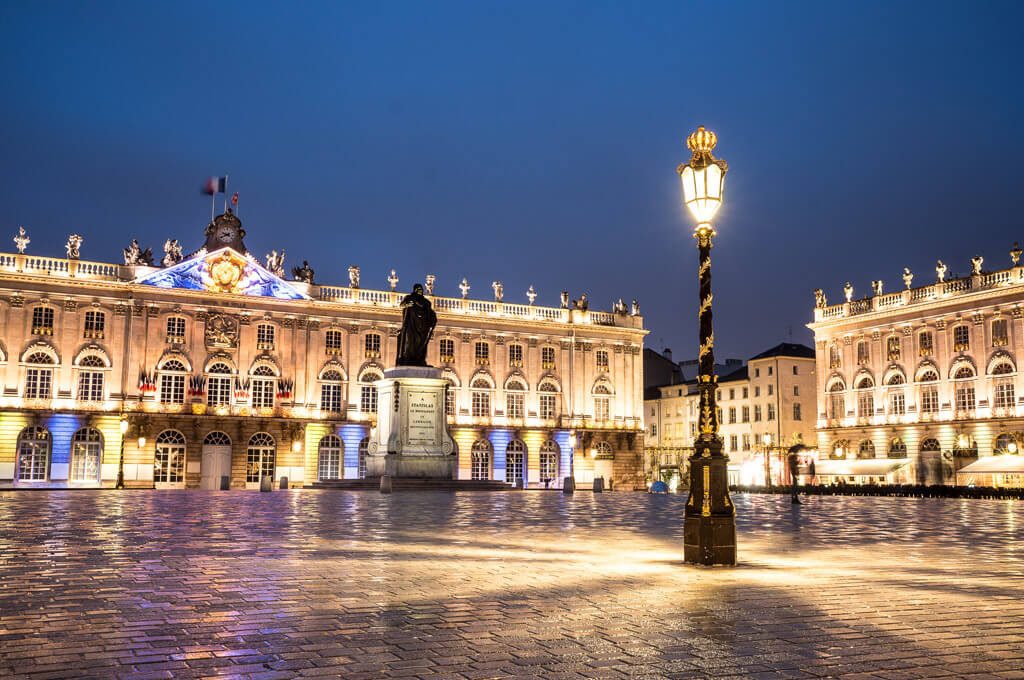
This 2 week France itinerary by train explores Paris and some of the most beautiful places in the Grand Est region (Alsace and Lorraine).
If this is your first time in Paris, you can use this itinerary for 3 days in Paris , which dedicates two days to exploring the Seine’s right bank and one day on the left bank. For the last day, choose one of these day trips from Paris .
If you count on visiting many museums and Paris landmarks, consider purchasing the Paris Museum Pass for 2 days . There are many historical buildings outside Paris included in this Paris Museum Pass; check it out!
For your stay in Paris, book at the Handsome Hotel by Elegancia . Located just 800 meters from the Louvre, this hotel offers its guests great facilities and always gets the best reviews.
Stop 2 | Colmar (4 days)
Colmar train station is connected to Paris by TGV trains or German ICE trains. There are 2-3 direct connections daily, while the rest of the connections imply a change of trains in Strasbourg. Count on it taking 2 hrs 50 min from Paris Gare de l’Est train station.
Click here to book your train tickets to Colmar
This France 2-week itinerary continues in Colmar , one of the most picturesque cities in the Alsace region . Colmar’s Old Town has a beautiful ensemble of half-timbered houses, quaint canals, and many interesting sites. Colmar is also a must of the Alsace Wine Route and an excellent base to explore some of the most beautiful Alsace villages on day trips.
For your stay in Colmar, book at the Hotel Le Colombier , a charming property located in the district of Little Venice, with spacious and stylish rooms, a bar, and a garden.
Colmar highlights:
- The Unterlinden Museum
- The Bartholdi Museum
- Little Venice
- The Food Market
- The Toy Museum
- The Choco-Story Colmar
- Best things to do in Colmar
Spend the first day in Colmar exploring the city – use this list of best things to do in Colmar to create your own itinerary. On day 2, take a day tour to visit other Alsace attractions . We like this Alsace Villages Tour and Wine Tasting , which visits pretty Alsace villages , the medieval Château du Haut-Koenigsbourg , and it comes with some wine tastings at a typical wine bar.
Stop 3 | Strasbourg (3 days)
Strasbourg is connected to Colmar by regional trains (TER) and TGV trains. The Swiss Railways also cover this connection. Count on it taking 33 min from Colmar to Strasbourg.
Click here to book your train tickets to Strasbourg
Strasbourg is the capital of the Grand Est region and the Alsace region. It is an interesting and lively city worth visiting during your France by train itinerary. Strasbourg is world-known for the Strasbourg Christmas Market , the oldest in France! The Old Town boasts some beautiful architecture and one of the best Gothic cathedrals in France.
Strasbourg highlights:
- Notre Dame Cathedral
- The Petite-France, a picturesque neighborhood
- The covered bridges and the barrage Vauban
- Strasbourg river cruise
- History Museum
- The European neighborhood
- Best things to do in Strasbourg
In Strasbourg, book two nights at the Hotel Cathédrale , located just opposite Notre Dame de Strasbourg , with incredible and spectacular views over the cathedral.
For your stay in Strasbourg, check out this Strasbourg in 2 days itinerary , or choose some activities from this list of best things to do in Strasbourg . If you want to see more of the Alsace region, consider one of these day trips from Strasbourg .
Stop 4 | Nancy (3 days)
Nancy-Ville train station is connected to Strasbourg-Ville train station by regional trains (TER) trains. Count on it taking 1 hr 30 min from Strasbourg to Nancy.
Click here to book your train tickets to Nancy
Nancy is one of the most dynamic cities in the Grand Est region. Thanks to a rich past, the former capital of the Duchy of Lorraine boasts today a sumptuous architectural heritage and can rightfully be considered one of the most beautiful cities in Europe.
For a long time, Nancy was considered the European capital of Art Nouveau. The 18th-century Stanislas Square , built in classic and rococo style, is one of the most beautiful squares in Europe, if not the most beautiful one!
Nancy highlights
- Place Stanislas
- Parc de la Pepinière
- Musée des Beaux-Arts
- The Ducal Palace
- Villa Majorelle
- Notre Dame de l’Annonciation Cathedral
For your stay in Nancy, book at Hotel de Guise Nancy Vieille Ville . Set in a historic building in the Old Town, the hotel offers comfortable rooms and beautiful interiors and decorations.
France Itinerary 14 Days #3: Paris – Rouen – Bayeux – Mont St. Michel
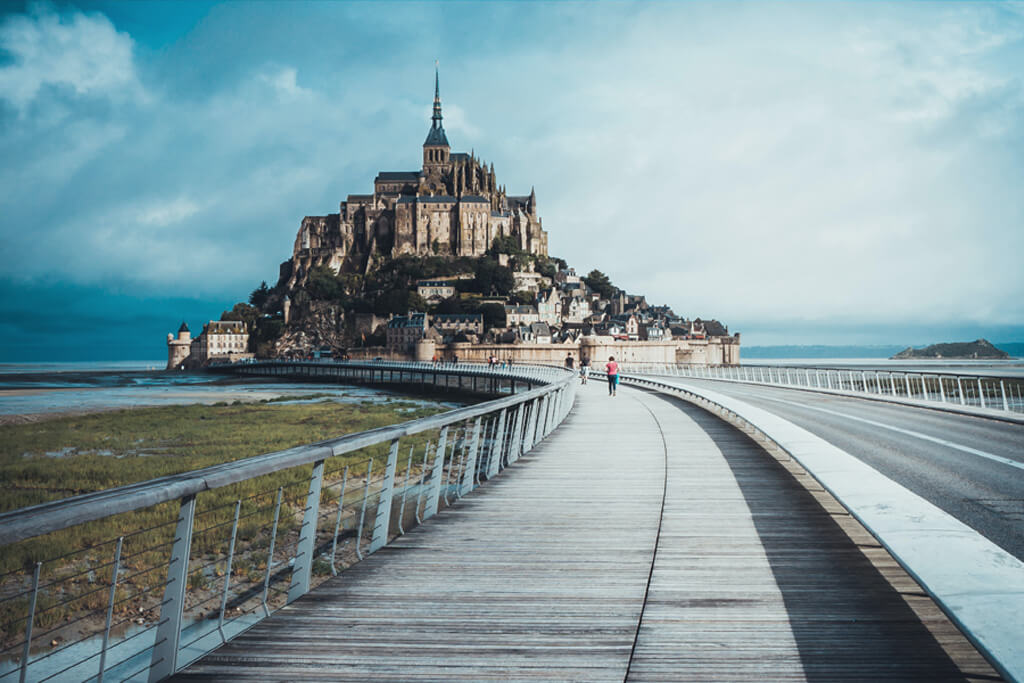
This beautiful France itinerary 14 days by train, travels through Normandy , visiting vibrant cities, historical sites, and the wonder of Western France.
Stop 1 | Paris (5 days)
Start your France train itinerary in Paris , the City of Light. For your stay in the French capital, use the Paris 5-day itinerary , which covers the city’s main highlights and a couple of sites nearby. You can also check this list of the best things to do in Paris and craft your own Paris itinerary.
For your stay in Paris, book at the Hotel de l’Abbaye , in Saint-Germain-des-Prés. Located just 800 meters from the lovely Luxembourg Gardens, this hotel offers its guests great facilities and always gets the best reviews.
Stop 2 | Rouen (3 days)
Rouen’s main train station is Rouen Rive Droite which is well connected to Paris by regional trains (TER). Count on it taking 2 hrs from Paris Saint Lazare train station.
Click here to book your train tickets to Rouen
Rouen is one of the main cities in Normandy , and it boasts the best-preserved medieval center in all of France, with beautiful architecture and picturesque cobbled streets. Nicknamed ‘the City of 100 Bell Towers,’ which dominate the city’s skyline, Rouen is also famous for being the place where Jeanne d’Arc was burned alive.
Rouen highlights
- Musée le Seq des Tournelles
- Historial Jeanne d’Arc – her trial site turned into a museum
- Tour Jeanne d’Arc
- Eglise Sainte Jeanne d’Arc de Rouen
- Old Market Square
- Notre Dame de Rouen Cathedral
- Picnic lunch in the Jardin des Plantes
- Best things to do in Rouen
For your stay in Rouen, book at the Best Western Plus Hotel Litteraire Gustave Flaubert , inspired by the French poet who was born in Rouen. The hotel has a central location in the Old Town and a beautiful terrace from where you can admire Rouen’s famous skyline.
Spend two days strolling around this beautiful city and visiting its main highlights. For your third day in Rouen, take a day trip to Giverny to see Monet’s gardens . You can travel by train to Vernon (40 min) and then jump on a bus to Giverny (10 min, five buses a day).
Stop 3 | Bayeux (3 days)
Bayeux is well connected to Rouen Rive Droite train station by regional trains (TER). All the options include a change of trains in Caen. Count on it taking 2 hrs 40 min from Rouen to Bayeux.
Click here to book your train tickets to Bayeux
The lovely city of Bayeux may not be large, but it boasts plenty of worthwhile sights. Bayeux’s attractive center is dominated by the imposing Cathedral de Notre Dame , built in Gothic style and consecrated with the presence of William the Conqueror. However, a bigger drawcard is the Bayeux Tapestry , a 70-meter-long embroidery that depicts the Battle of Hastings when William the Conqueror invaded England in 1066.
For your night in Bayeux, we recommend Clos de Bellefontaine B&B , a beautiful 19th-century private mansion set in a beautiful 2,000m2 park, with private parking on-site. Clos de Bellefontaine is located 200m from the Bayeux Tapestry.
Bayeux highlights
- Bayeux Cathedral
- The Bayeux Tapestry
- 19h-century Botanical Gardens (labeled Historical Site of France)
- Bayeux Market
Bayeux is also an excellent base to explore the D-day Landing sites of Normandy . This American D-Day Sites in Normandy Tour is a very informative and in-depth tour of the main battle points, and it always gets excellent reviews.
Stop 4 | Mont Saint-Michel (2 days)
The train journey from Bayeux to Mont Saint-Michel is easy to plan. Count on it taking 3 hrs 45 min by regional train (TER) with a change of trains in Pontorson . From Le Mont St-Michel train station, it’s a 7 min walk (570 m) to the abbey.
Click here to book your train tickets to Mont St.Michel
These two weeks in France by train end with a visit to Mont Saint-Michel . This stunning island abbey is also known as the Wonder of Western Europe.
Located at the border with Brittany, Mont Saint-Michel was for centuries one of Europe’s major pilgrimage destinations, and today, 2.5 million tourists from around the world flock here every year. In the bay of Mont Saint-Michel, you will also see Europe’s highest tides!
You can visit Mont St-Michel alone – book your ticket with priority entrance . You can also fly over Saint-Michel Bay to admire the famous Abbey from the sky.
For a more relaxed trip, spend one night on-site in one of the hotels in Mont Saint Michel . Wander around the medieval streets when the crowds are gone and watch the waters rise to inundate the entrance to the island. The hotel Le Mouton Blanc is one of the best hotels in Mont St-Michel, nestled at the foot of the famous abbey. Le Mouton Blanc dates back to the 14th century, and it is perfect if you want to really soak in the island’s past.

14 Days in France Train Itinerary #4: Nice – Cannes – Marseille – Toulouse
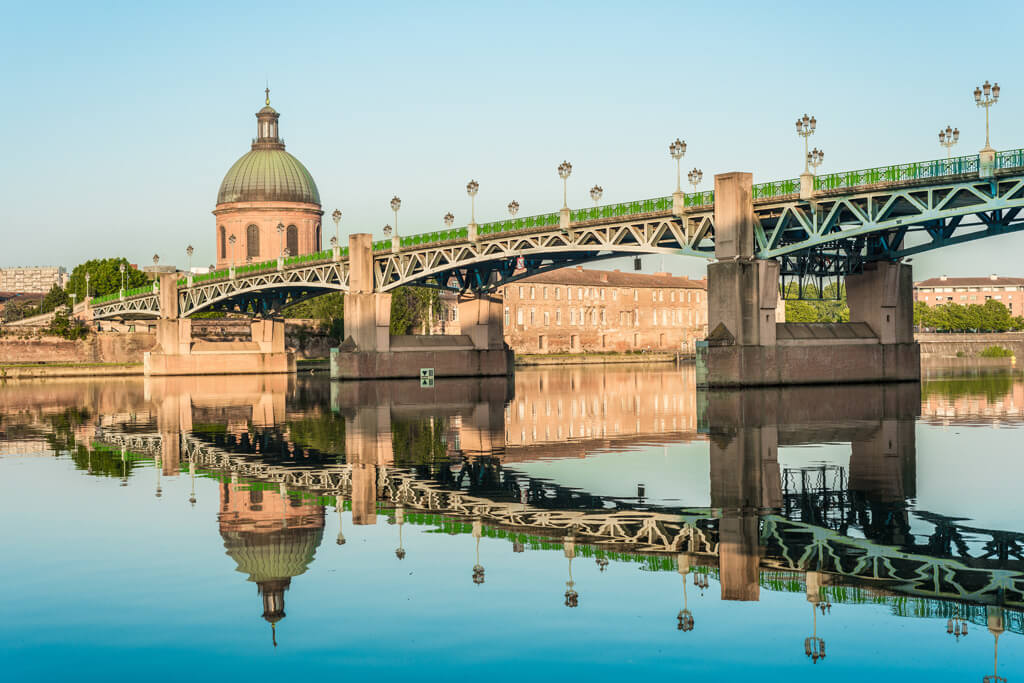
This south of France itinerary by train starts in Nice , and it explores some of the most beautiful places in the regions of Occitanie and Provence-Alpes-Côte d’Azur, with the possibility of many lovely day trips.
Stop 1 | Nice (4 days)
You can reach Nice by train from Paris and many other French cities. Nice Airport (NCE) is the third busiest international airport in France , and it covers many international destinations in Europe, Africa, Asia, the Middle East, and America via regular or seasonal flights – Check out how to travel from Nice Airport to the city .
Click here to book your flight tickets to Nice
Nice is one of the best places to visit in the French Riviera , a must of any trip to Southern France. Spend two days in Nice and use the rest of your time visiting other places on day trips. We especially like Menton , but the city-state of Monaco and Eze-Village are also good options.
For your stay in Nice, book at the Hotel La Pérouse Nice Baie des Anges . This 4-star hotel is nestled into the Colline du Château, and it comes with a great view over the Baie des Anges. Summers in Nice are hot, and you will be happy to book one of the Nice hotels with a pool .
For more information about Nice, jump to the France two-week itinerary #1.
Stop 2 | Cannes (3 days)
Cannes’ train station is well connected to Nice by regional trains (TER). Count on it taking 30 to 40 min from Nice Ville train station.
Click here to book your train tickets to Cannes
Cannes is one of the most glamorous places on the French Riviera, world-famous for its cinema festival. However, Cannes has retained its authentic Provencal charms and offers visitors much more than walking the legendary carpet and social events.
Cannes highlights
- Le Suquet neighborhood
- La Croisette promenade
- Notre Dame d’Espérance Church
- Chic shopping at Rue d’Antibes
- Cannes’ sandy beaches
- Best things to do in Cannes
For your stay in Cannes, the Villa Pruly Hotel Cannes Centre is an excellent option. This 3-star hotel, recently renovated, is located a 5-minute walk from the beach, and it has charming rooms, a lush garden, and a terrace with sun loungers.
Use the first two days in Cannes to visit the city and relax on the beach. On the third day, you can opt for a catamaran cruise with lunch or explore Sainte-Marguerite – the biggest of the Lérins Islands – on a day trip. Located off the city of Cannes, Sainte-Marguerite is the easiest Lérins island to reach by ferry, and it has some lovely beaches far from the Cannes crowds – Book your ferry tickets to Sainte-Marguerite
Marseille’s main station is Marseille St Charles , and it is well connected to Cannes by TGV and regional trains. Count on it taking 2 hrs 10 min from Cannes train station.
The capital of the Provence-Alpes-Côte-d’Azur , Marseille is an exciting and lively city great for culturally curious visitors and nature lovers.
For the list of things to do in Marseille, jump to the France by train itinerary Option 1. For your stay in Marseille, Hotel la Résidence du Vieux Port is a great choice, with the perfect location – on the banks of the Old Port – and the best view of Marseille.
Stop 4 | Toulouse (3 days)
Toulouse’s main station is Toulouse Matabiau, and it is well connected to Marseille by Intercités trains. Count on it taking 3 hrs 50 min from Marseille Saint-Charles train station.
Click here to book your train tickets to Toulouse
Toulouse is the capital of the Occitanie region in Southern France. Nicknamed ‘the Pink City’ because of the color of the stone used for its buildings, Toulouse is a lively city with pretty little squares, elegant private mansions, interesting museums, and beautiful parks.
Toulouse highlights
- Place du Capitole
- The private mansions
- Saint-Sernin Basilica
- The Cité de l’Espace
- Things to do in Toulouse
Toulouse is easy to visit in two days. Use the third day to visit the medieval Cité de Carcassonne . The train journey to Carcassonne takes only 1 hour, and you will love the citadel and the history of the Cathars and the Crusaders behind it.
For your stay in Toulouse, the Ibis Styles Toulouse Capitole has an unbeatable location on the city’s main square, and it offers an excellent breakfast in a pleasant open space.
France 2 Week Itinerary #5: Paris – La Rochelle – Bordeaux – Biarritz
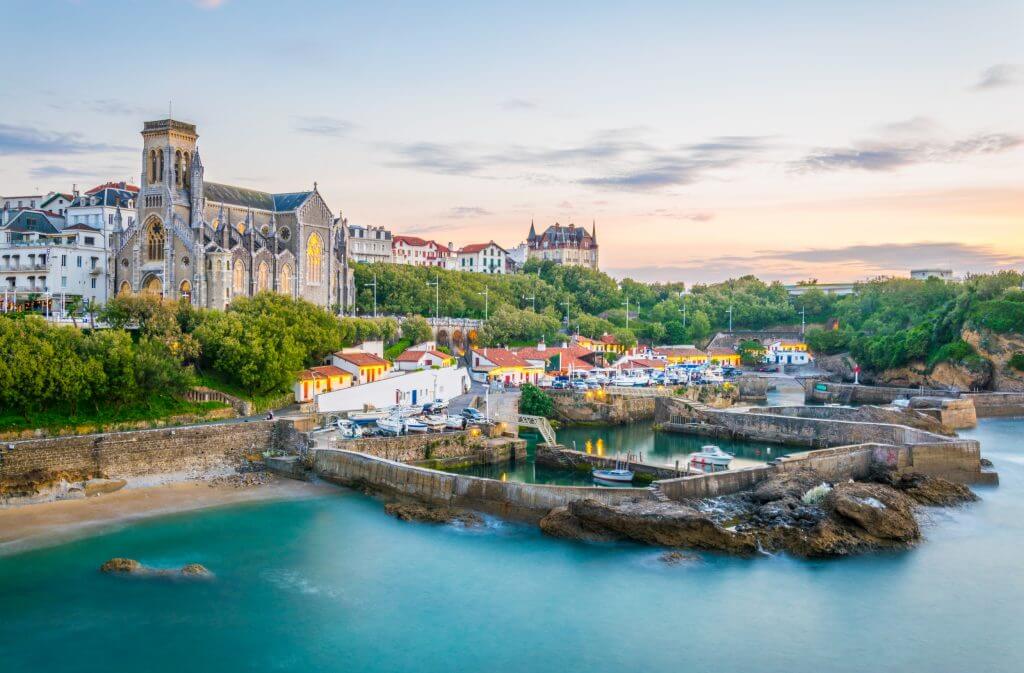
This 2 weeks in France itinerary by train starts from Paris , and it explores some of the most beautiful cities in Western France. Spend 14 days in France, combining sightseeing with relaxing days by the beach.
Stop 1 | Paris (3 days)
For your three days in the French capital, you can use this Paris 3-day itinerary or craft your own itinerary from this Paris bucket list . You can also use this itinerary for Paris in one day plus two of these day trips from Paris by train .
Stop 2 | La Rochelle (3 days)
La Rochelle’s main station is La Rochelle Ville, and it is well connected to Paris by TGV trains. Most of the train connections are direct, while others imply a change of trains in Poitiers. Depending on the train chosen, count on it taking 3 to 4 hrs from Paris Montparnasse train station.
Click here to book your train tickets to La Rochelle
La Rochelle is a historic seaport in the Bay of Biscay along the sandy west coast of France. It is the perfect little city for a relaxing break by the ocean and a great base to explore the area.
La Rochelle’s main feature and attraction is the Old Port , which is central to nightlife and restaurants. La Rochelle is also rich in culture, architecture, and gastronomy.
La Rochelle highlights
- Towers of La Rochelle (14th century)
- La Rochelle Heritage Segway tour
- Local market
- The Aquarium
For your stay at La Rochelle, we recommend Hotel Les Brises . Located on the seafront, just 1.9 km from the Old Port, Hotel Les Brises offers lovely rooms with sea views.
After some busy days in Paris, you may want to take your time to visit La Rochelle and its surrounding area. Use one or two days to visit the city. For the rest of the days, head to Châtelaillon-Plage (15km south) to enjoy the beah. You can also take a sailing cruise to reach the famous Fort Boyard or cross the bridge to Ile de Re for a lovely day in one of the most beautiful French islands .
Stop 3 | Bordeaux (4 days)
Bordeaux’s main station is Bordeaux Saint-Jean, and it is well connected to La Rochelle by regional trains (TER) or Intercités trains. Count on it taking 2 hrs 40 min from La Rochelle Ville train station.
Click here to book your train tickets to Bordeaux
Bordeaux is the capital of the Nouvelle-Aquitaine region. Home to some of the world’s best wines, sites like the Wine Museum or the Cité du Vin are ideal to start your wine explorations. Bordeaux is also known for its beautiful collection of 17th-century private mansions, excellent restaurants and pastry shops, and the world’s largest reflecting pool.
If you count on visiting many museums and landmarks in the city, consider purchasing the Bordeaux City Pass for 2 or 3 days .
Bordeaux highlights
- Port of the Moon (UNESCO perimeter)
- Place de la Bourse
- The Water Mirror
- Cité du Vin
- Garonne River Cruise
- Best things to do in Bordeaux
For your stay in Bordeaux, we recommend the Yndo Hotel , set in a 19th-century private mansion in the heart of Bordeaux, this chic hotel features individually decorated rooms, a fragrance garden, and a sun terrace.
Bordeaux is also a great base to explore the wine country or the Atlantic Ocean on day trips. Spend two days visiting Saint Émilion , a town world-known for its wines, and the Bay of Arcachon with Dune du Pilat .
Stop 4 | Biarritz (4 days)
Biarritz’s train station is well connected to Bordeaux by regional trains (TER). Count on it taking 2 hrs from Bordeaux Saint-Jean train station. Biarritz train station is far from the city center, but it is well connected to the city center by bus.
Click here to book your train tickets to Biarritz
This two weeks in France train itinerary ends in Biarritz , a splendid seaside resort nestled in the Bay of Biscay on the Atlantic coast. You will most likely fall in love with Biarritz, a lively city with magnificent vestiges of the past, exceptional cultural sites, and rich natural heritage.
For your stay in Biarritz, book at Hotel Windsor Grande Plage . Located in an ancient private mansion facing the Grande Plage beach, the hotel is ideally situated close to the main attractions.
Biarritz highlights
- Les Halles (local market)
- Grande Plage with Sainte Eugénie Church and the Basta Rock
- Biarritz’s lighthouse
- Le Rocher de la Vierge
- Views from the Atalaya Plateau
- Best things to do in Biarritz
Visit Biarritz in one or two days and spend the rest of your time visiting other places in the Basque Country. The lovely town of Saint-Jean-de-Luz and the city of Bayonne are easy to reach by train from Biarritz.
2 Weeks in France by Train Itinerary #6: French Wine Regions
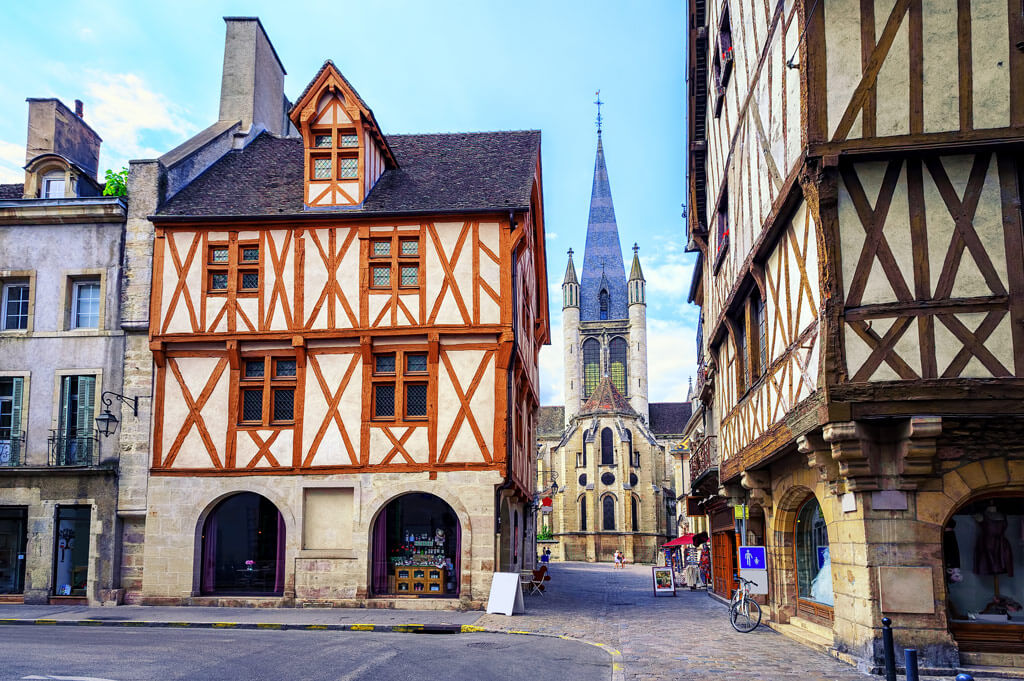
This two weeks in France itinerary explores some of the best wine areas in France . This France train itinerary starts from Paris CDG TGV airport, and it is perfect for wine lovers.
TIP: If you plan to bring a few bottles home (who could resist?!), make sure you pack your wine properly so it arrives safely home!
Stop 1 | Lyon (3 days)
Lyon’s main station is Lyon-Part-Dieu , and it is connected to Paris CDG Airport by TGV trains. Count on it taking 2 hrs from Paris CDG Airpot train station.
Click here to book your train tickets to Lyon
Lyon is a beautiful and cultural city, bisected by the river Rhône from north to south. The city has an interesting Roman heritage and interesting museums, and it is also an excellent place for enjoying good food and wine. The Old Town has a fascinating network of hidden passages, the traboules , that you must explore when visiting Lyon.
For your stay in Lyon, book at Villa Florentine . This former convent, located in the heart of Old Lyon, offers elegant guest rooms and fabulous panoramic views of the city.
For your visit to Lyon, steal this 2 days in Lyon itinerary . or choose your favorite activities from this list of best things to do in Lyon .
If you count on visiting many museums and landmarks, consider purchasing the Lyon City Pass for 1 or 2 days .
Lyon highlights:
- Saint-Jean Cathedral
- Lugdunum – Musée et Théâtres Romains
- Fourvière Hill and Basilica
- Old Lyon and the Saône River Banks
- Parc de la Tête d’Or
- Lyon e-bike tour
- Musée des Confluences
- Best things to do in Lyon
Lyon is an excellent place to explore the Rhône Valley wine region , which produces some of the most renowned wines in France, most notably its full-bodied reds. Visit some wineries in the Hermitage and Côte-Rôtie appellations, meet the winemakers, and sample a variety of Côtes du Rhône wines with this guided tour from Lyon .
Also, Lyon is not far from the Beaujolais Wine Region (wines of Burgundy), which produces vibrant, fruity wines with the Gamay grape variety. The Beaujolais Wine Region also boasts an exceptional heritage of beguiling villages, old churches, beautiful estates, and country roads that complement this rural paradise. Discover Southern Beaujolais with this unusual and gourmet tour with tastings that will show the highlights of this beautiful region, from history to wine!
Stop 2 | Dijon (3 days)
Dijon’s main station is Dijon Ville , and it has direct connections with Lyon with regional trains (TER), and there are also some TGV trains. Count on taking 2 hours from Lyon Part Dieu to Dijon Ville.
Click here to buy your train tickets to Dijon
Dijon is the capital of the Burgundy region and is probably best known for its picturesque architecture and great wine. It was home to the Dukes of Burgundy, and as such, it has a fascinating cultural and architectural heritage. And of course, it also has incredible food, just like the rest of France.
In Dijon, the Grand Hotel La Cloche Dijon is a good option, conveniently located close to all the main attractions.
Visit the Old Town , which became a UNESCO World Heritage site in 2015 and is full of beautiful, half-timbered houses and little squares. Before exploring the surrounding vineyards, we suggest taking this wine master class with tastings to get to know the Burgundy wines.
Dijon highlights:
- Hotel de Ville
- Jardin des Ducs
- Musée des Beaux-Arts, in the Palace of the Dukes
- Notre Dame Church
- Central Market
- Best things to do in Dijon
Dijon is one of the main stops of the Route des Grands Crus , and you can visit some parts of it by train or with a guided bike tour .
Take a train to Beaune (no need to buy train tickets in advance) to visit the famous Hospices de Beaune and do some tastings. Domaine Chanson and Maison Champy offer tours with tastings in English (book in advance).
Stop 3 | Reims (3 days)
Reims’ main train station is Gare de Reims and it is connected with Dijon via regional trains and TGV trains. There is only one direct connection a day between Dijon and Reims , which we recommend taking. Connections with a transfer in Paris arrive at Paris Gare de Lyon and depart from Paris Gare de l’Est , so you will need to take the metro between the two train stations in Paris.
Click here to buy your train tickets to Reims
The capital of Champagne, with many historical gems to visit, is undeniably an important place for French history. Between sipping champagne wine , visiting the main sites, and experiencing a memorable and moving visit to a critical piece of WWII history, there are many things to do in Reims .
For your night in Reims, we recommend the Domaine Les Crayères , an iconic property in the city nestled in a seven hectares park, 300m from the Pommery Champagne House. Inaugurated by the Marquise de Polignac, this wonderful villa belonged to her descendants until 1978.
Reims is famous for its magnificent Cathedral Notre Dame de Reims , which is one of the best Gothic Cathedrals in France . From King Clovis to the French Revolution, almost all the Capetian Kings of France were crowned in the Reims Cathedral.
Reims highlights
- Palais de Tau
- Saint-Remi Church
- Champagne Tasting
- Art-Déco architecture
- Taste the rose biscuits
- Best things to do in Reims
If you go for a champagne tasting, which we recommend!, check out this article on the best champagne houses in Reims . You can also explore the surrounding vineyards by e-bike or take a day trip by train to the champagne town of Epernay (no need to book train tickets in advance).
Stop 4 | Paris (1 day)
Paris Gare de l’Est is one of the capital’s main train stations. Gare de l’Est serves the main cities in Eastern France, and also Germany. Count on taking it 1 hour from Gare de Reims to Gare de l’Est .
Click here to buy your train tickets to Paris
This 2-week itinerary France only spends one night in Paris. If this is your first time in Paris, you can decide to stay more time in the French capital. For only one night in Paris, you can use this one-day Paris itinerary , which covers the main sights. If you have already been to Paris, go off the beaten path and check out a few of these lovely hidden gems in Paris .
For your stay in Paris, book at one of these lovely hotels near Gare du Nord , which is just in front of Gare de l’Est. When you arrive from Reims, avoid the hassle of taking the metro with your luggage. From here, you have direct metro connections to Gare de Montparnasse for the day after.
Stop 5 | Bordeaux (4 days)
Bordeaux’s main station is Bordeaux Saint-Jean and it has fast and direct connections from Paris (count on taking it 2 hrs 30 min from Paris Gare Montparnasse to Bordeaux Saint-Jean . On the way back home, you can take a train from Bordeaux directly to Paris Charles de Gaulle Airport . Bordeaux has some (but not all) direct connections with Paris CDG Airport. Count on taking it 3h 45 m from Paris CDG Airport to Bordeaux St-Jean with direct trains.
This France itinerary 2 weeks ends in Bordeaux , home to some of the world’s best wines. The city is located in the region of Nouvelle-Aquitaine , in Western France, and it is bisected by the Garonne River . Don’t miss Bordeaux’s beautiful collection of private mansions from the 17 century, and of course, its wine shops and bars!
For your stay in Bordeaux, we recommend the Hotel La Cour Carrée Bordeaux Centre , set in a 19th-century private mansion in the heart of Bordeaux. This beautiful hotel features individually decorated rooms, all air-conditioned, and a terraced patio.
For your visit to Bordeaux, we recommend starting with a guided walking tour to learn more about the city’s history. This top-rated Bordeaux wine master class will help you decode the complexity of Bordeaux wines. If you count on visiting many museums and landmarks, consider purchasing the Bordeaux City Pass for 2 or 3 days .
- The water mirror
- Bassin des Lumières
- Garonne River Cruise with a glass of wine
Bordeaux is the perfect base to explore the wine areas of Saint-Émilion and Médoc . There’s a direct regional train that connects Bordeaux Saint-Jean to Saint Emilion (30 min, one way). However, we recommend this Saint Emilion wine tour if you also wish to explore the wine châteaux.
Take this Médoc guided tour with tastings to follow Medoc’s famous Route des Châteaux and learn all about different wine-tasting techniques along the way.
So there you have it, our selection of the best itineraries to spend 2 weeks in France. Which France by train itinerary tempts you most?
Click here for more Travel Inspiration
Back to Homepage
Disclaimer: This article may contain compensated links, meaning we get a small commission if you make a purchase through our links. It costs you nothing more (in fact, if anything, you’ll get a nice discount) but helps us to go on creating incredible French content for you. We trust all products and brands promoted here and would never recommend anything that isn’t of value. Please read disclaimer for more info.
(C) Copyright 2019 - 2024 France Bucket List. All Rights Reserved. Designed & Developed by France Bucket List || Disclaimer || Privacy Policy || Contact |

The Man in Seat 61
A guide to France's TGV
Train à grande vitesse.
- Buy train tickets
- Buy ferry tickets
- Book a hotel
- Privacy & cookies
- Home
Train travel UK & Ireland...
Train travel in europe..., train travel in asia..., train travel in africa..., train travel in america..., train travel in australasia, a guide to travel by tgv.
TGVs or Trains à Grande Vitesse are the pride of SNCF (French Railways), running at up to 300 km/h (186 mph) on a high-speed network linking towns & cities across France. In fact, trains reach 320 km/h (199 mph) on the newer TGV-Est & TGV-Rhin-Rhone routes. Smooth & quiet even at high speed, it's a relaxing way to travel. Some TGVs are single-deck , an increasing number are double-deck TGV Duplex .
Since 2017 SNCF's TGVs have been marketed under the brand name InOui , French for unheard of or exceptional .
Fares & tickets
Seat reservation is compulsory on TGVs, all tickets include a seat reservation on a specific train. TGV seat maps .
Fares vary like air fares, with cheap Prems fares if you book in advance, much more expensive flexible fares if you buy close to departure date.
Paris to Nice starts at €25, Paris to Bordeaux from €20, if you book a cheap Prems fare in advance. Booking opens up to 4 months ahead.
Buy tickets at www.raileurope.com or www.thetrainline.com (both easy to use, in €, £ or $, overseas credit cards no problem, small booking fee or at the French Railways website www.sncf-connect.com , same fares, no fee.
You can select seats from a seat map when booking a 1st class ticket at www.thetrainline.com or www.sncf-connect.com .
Click for table comparing the fees & features of the various sites selling TGV tickets
1st class seats
2nd class seats, luggage & facilities on board.
Luggage limits: Since February 2024 SNCF has had a more formal luggage policy for TGV InOui which will be enforced from September: There are no weight limits, but you must be able to carry it yourself in one go. You can carry either 1 hand luggage + 2 suitcases or 1 hand luggage + 1 suitcase + 1 specific item. Your hand luggage can measure up to 40 cm x 30 cm x 15 cm. Your suitcase(s) can measure up to 90 cm x 70 cm x 50 cm. Your specific item (musical instrument, pushchair, bike in cover, folded bike, scooter) can measure up to 130 cm x 90 cm. Bikes, musical instruments, snowboards, and skis must be under a labelled cover. You can travel with your pair of skis, without a maximum size, one pair per person. If you exceed these limits there's a €50 fee, but it's not yet clear how tough staff will be.
Travel tips
It's only possible to specify forward-facing seats on a handful of TGV routes which have the Christian Lacroix interiors which feature variable illuminated seat numbers - the correct set of seat numbers illuminate depending which way round the TGV unit enters service. Such routes include single-deck TGV services on TGV Est (Paris to Reims, Metz, Strasbourg, Luxembourg, but not trains operated by TGV Duplex). You'll only be given the option to specify forward facing seats if (a) you book using www.raileurope.com or www.thetrainline.com or www.sncf-connect.com and (b) the specific route and type of TGV supports this feature. Most routes & TGVs don't, it's only a few that do.
Or bring your own food & drink
Back to top
Single-deck TGVs
The christian lacroix interior, later interiors.
Another TGV refurbishment is in progress, so you'll see interiors like this starting to appear along with a new grey, silver & red TGV livery.
Older interiors
There are still some unrefurbished TGVs knocking about, and these older interiors often don't have power sockets in 2nd class.
Video guide: Christian Lacroix TGV
The original patterned carpet and mixed lime green and grey seats in 1st class have now been replaced by all-grey seats & grey carpet, watering down the design.

Double-deck TGV Duplex
1st generation tgv duplex.
1st generation TGV Duplex operate on French domestic routes including Paris-Lyon, Paris-Marseille, Paris-Nice, where they work alongside newer 2nd & 3rd generation trains. There are power sockets at all 1st class seats, but usually not in 2nd class on these first-generation trains. The first-generation trains are not equipped to run on international routes.
2nd & 3rd generation TGV Duplex
Tgv duplex océane.
3rd generation trains with a completely redesigned interior known as TGV Océane entered service in 2017, initially on the TGV Atlantique route from Paris Montparnasse to Brittany, Bordeaux, Biarritz, Lourdes & Hendaye on the Spanish border. Some now also operate from Paris to Lyon and the south of France. All seats in both classes have power sockets & free WiFi, 1st class seats also have USB ports. A major innovation is that 1st class seats rotate to face direction of travel. The seats at the very end of each car don't rotate. The new Océane interior may be retrofitted to earlier TGV Duplex sets in due course.
A TGV Duplex Océane from Paris arrived at Bordeaux St Jean. These TGV Duplex carry the latest grey, silver and red TGV colours and have an all-new interior.
TGV Océane cafe-bar (above left) and 2nd class seats (above right).
TGV Océane 1st class seats . All 1st class seats (except the end ones) rotate to face direction of travel. There are USB & 2-pin outlets above each drop-down table.
Video guide: TGV Duplex
Sample tgv café-bar menu.
This photo of a TGV bar menu gives you an idea of what's on offer in a typical TGV cafe-bar. Prices are from Autumn 2017.
Click the image to enlarge .
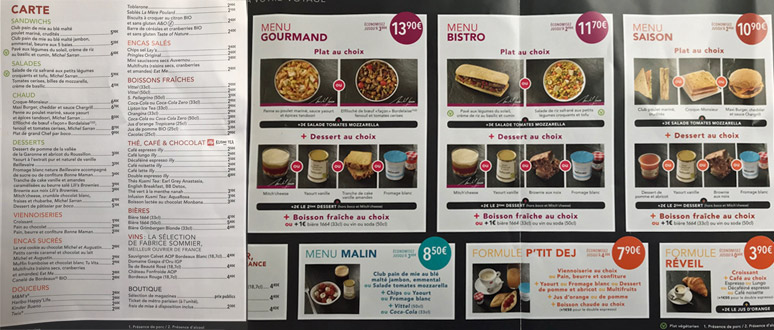
Back to home page
Subscribe to The Connexion
See prices & plans
HELP GUIDES
Income Tax in France
Healthcare in France
Inheritance Law and Wills in France
Visas and residency cards for France
Destinations, rules: All about €49 French rail pass on sale from June 5
The pass - inspired by the German D-Ticket and the UK’s 16-25 Railcard - is aiming to encourage more train travel during the summer

Do you receive The Connexion's free weekday newsletter?
Sign up here

French residency permit delays spark protest - how long should it take?

New cars in France must have these features from July

Angry French and Spanish farmers block motorway in 24-hour action
A new €49 rail pass is to go on sale in France tomorrow (June 5) in a bid to encourage more young people to use the train network this summer.
The pass, Le Pass Rail, will cost €49 per month for unlimited use on trains across the country, and will be available to everyone aged 16-27.
Inspired by Germany’s similar Deutschlandticket (D-Ticket, also €49 per month), and also similar to the UK’s 16-25 Railcard (£30, around €35), it will enable users to save money on train tickets on everyday journeys as well as longer-distance trips.
The Pass Rail is to be funded to 80% by the state (a cost of €15 million), with the rest funded by the relevant regional councils. Of the income generated, 85% will go back to local authorities, and the rest back to the state.
‘Good for the environment and for savings’
The pass was first proposed by former Transport Minister Clément Beaune and received support from President Emmanuel Macron last year.
Read also: Flat rate rail pass could be introduced in France next summer
As the pass is intended for younger people, the president has been using social media channels to publicise its introduction.
In September, he publicly promised that the pass would be introduced, to French YouTuber and journalist Hugo Décrypte, and today (June 4) he wrote on Instagram: “Commitment kept, the Rail Pass has been introduced. It's good for the environment and it's good for savings. Sign up now!”
Current Transport Minister Patrice Vergriete has described the pass as a way to access special “pricing for young people to enable them to discover all the regions of our beautiful country”.
View this post on Instagram A post shared by Emmanuel Macron (@emmanuelmacron)
When can the pass be used?
In contrast to the D-Ticket and 16-25 Railcard (which are valid year-round), the Pass Rail is - so far - only set to be available for the months of July and August 2024.
The pass will cost €49 per month from the date of purchase. For example, a card bought on July 14 would be valid until August 14.
What trains can the pass be used for?
Pass holders will have unlimited travel on regional TER and Intercités trains.
The existing Intercités routes are:
- Nantes > Lyon
- Nantes > Bordeaux
- Marseille > Toulouse > Bordeaux
- Clermont-Ferrand > Paris
- Béziers > Clermont-Ferrand
- Paris > Limoges > Toulouse
- Bordeaux > Toulouse > Marseille
- Night train services (from Paris to Toulouse, Rodez, Latour-de-Carol, Cerbère, Tarbes, Briançon, Nice and Aurillac).
Users will also be able to use the pass for connecting TER services between regions and routes.
Read also: Ways to save money on train travel in France
What trains can the pass not be used for?
The pass is not valid for:
- Ouigo Train ‘classique’
- Eurostar
- Transilien trains in the Ile-de-France region (although the pass is set to be valid in the Ile-de-France region from 2025)
What are the terms?
The pass can only be used for:
- A maximum of one journey per day from the same town (including connecting services)
- A maximum of one journey per day in the same time slot
- A maximum of six tickets booked at the same time, so as not to hold up other passengers
The pass is only valid when:
- Presented with a valid ticket and ID when asked or required
- Used by a passenger aged 16-27
- Used during the months of July and August 2024
How can you get Le Pass Rail?
Frm June 5, it will be available to buy on the SNCF Connect app, and on a desktop site. The pass will only be available to buy online.
The Trainline app is also set to sell the pass from June 5.
Is the pass expected to be popular?
Rail company SNCF has estimated that around 700,000 people will take advantage of the card; around 10% of the population of 16-27s in France.
A Trainline poll has suggested that the number could be even higher, with 48% of the 16-27s questioned saying they would buy a Pass Rail ahead of going on holiday this summer.
Related articles

Baggage thefts on French trains on rise: travellers use GPS trackers
Smartphone-linked trackers are increasingly popular method to prevent thefts from luggage racks

€5 Ouigo train tickets on sale in flash anniversary offer in France
50,000 tickets are available over two days for the low cost trains
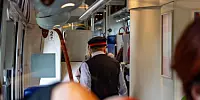
Do train staff in France really get commission from fines they give out?
Fines can be handed out for not having a valid ticket, using an out of date railcard, or even having your feet on the seat opposite

Bordeaux airport: ‘Ryanair pulling out was our worst-case scenario’
Withdrawal will lead to a 25% decrease in passenger numbers. EasyJet is maintaining its flights
What are the rules for drying clothes outside in France?
Partner article: Exploring the rules in France hanging out your washing
What are the recycling rules in France? Has something changed?
Briton with £163,000 cash in van has french jail sentence overturned, what must drivers carry in their cars in france are photocopies ok.

Paris air traffic controllers post strike notice for next week
A similar strike last month saw 70% of flights from Paris Orly impacted

Explosion in cases of whooping cough continues in France
Such a rise has not been seen for 40 years, a researcher at Institut Pasteur says

What is the net and gross minimum wage in France in 2024?
The minimum wage is updated at least once per year

Money Saver: How can I get the best longer term car-hire rates in France?
More people are requesting alternatives to standard holiday car hire

French school evacuated due to smell of… canteen’s goulash
Emergency services were called as odour was thought to be gas leak

VIDEO: Curious Dordogne river well back after rainiest May since 1981
The mesmerising ‘well’ is still somewhat of a mystery

Digital carte Vitale begins in many areas: where and how will it work?
Smartphone application can be used at medical appointments instead of physical card for payments and reimbursements

France’s A13 motorway to remain closed longer than expected
Some Paris Olympic events may be impacted
App lets blind hikers explore France
Voice-guided system can lead visually impaired people around adapted footpaths
French towns remember WWI with Western Front hiking trail
Right-wing tv news channel cnews becomes most popular in france, new french bill seeks to ban new second homes - where and how.

Demonstrators say titre de séjour renewals take too long - costing people their jobs and homes

Obligatory new tools will include automatic braking and lane departure warnings. Car costs are expected to rise by at least €500 per vehicle as a result

Paris Olympics: Hotels and Airbnb prices drop due to oversupply
Many Parisians hoped to make money renting out their homes
PHOTOS: 48 American veterans land in France for D-Day commemorations
They were welcomed by school children and the wife of French President Emmanuel Macron, Brigitte Macron
Alert over Wangiri telephone scams in France: What is this?
Arrests and suspected russian link over coffins left by eiffel tower, frenchman honours grandfather with tattoo of d-day across whole back.

Postal strikes loom for several areas of France
Delivering millions of political manifestos is a serious burden, workers say

CONFIRMED: €30 fee to see a doctor in France from December 2024
Unions agreed to concessions in exchange for improved pay

Surprise find for Australian who traced mystery WW1 photo to France
The grandfather of the woman who found it was deployed to the Somme with the Australian Imperial Force

The National's Bryce Dessner now calls France his home
The Connexion caught up with the US rock star ahead of his concert in Paris on June 5, discussing his life and experiences in France, and his career to date

‘How I was duped by French conman who claimed he was British MI6 spy’
The crook, who has lied, scammed, and deceived people for decades, also said he was a Scottish lord

Several points on the border are closed, or traffic is being diverted, with up to 1,000 tractors blockading the roads

Watch out for these scams as Paris prepares for 2024 Olympics
Free tickets, fake reviews, and scam tipping - watch out for these potential traps

Local police to join strike action during Paris Olympics
The municipal police are set to go on a nationwide strike for a month from mid-July to mid-August
UK Edition Change
- UK Politics
- News Videos
- Paris 2024 Olympics
- Rugby Union
- Sport Videos
- John Rentoul
- Mary Dejevsky
- Andrew Grice
- Sean O’Grady
- Photography
- Theatre & Dance
- Culture Videos
- Fitness & Wellbeing
- Food & Drink
- Health & Families
- Royal Family
- Electric Vehicles
- Car Insurance Deals
- Lifestyle Videos
- UK Hotel Reviews
- News & Advice
- Simon Calder
- Australia & New Zealand
- South America
- C. America & Caribbean
- Middle East
- Politics Explained
- News Analysis
- Today’s Edition
- Home & Garden
- Broadband deals
- Fashion & Beauty
- Travel & Outdoors
- Sports & Fitness
- Sustainable Living
- Climate Videos
- Solar Panels
- Behind The Headlines
- On The Ground
- Decomplicated
- You Ask The Questions
- Binge Watch
- Travel Smart
- Watch on your TV
- Crosswords & Puzzles
- Most Commented
- Newsletters
- Ask Me Anything
- Virtual Events
- Betting Sites
- Online Casinos
- Wine Offers
Thank you for registering
Please refresh the page or navigate to another page on the site to be automatically logged in Please refresh your browser to be logged in
Across France for £1.35 per day: A new deal for young rail travellers
Train talk: summer promotion emulates germany’s post-pandemic transport offer – but with an age limit, article bookmarked.
Find your bookmarks in your Independent Premium section, under my profile

Sign up to Simon Calder’s free travel email for expert advice and money-saving discounts
Get simon calder’s travel email, thanks for signing up to the simon calder’s travel email.
Young rail passengers will be able to roam wherever they wish on the French rail network during July and August for a flat rate of just £1.35 per day.
President Macron announced the plan for a one-month unlimited Le Pass Rail in September 2023. Initially it seemed to be an all-ages project intended to emulate the €49 Deutschlandticket – which opened up travel around Germany after the Covid pandemic.
After months of negotiations between central government, the regions and SNCF (French Railways), it turns out the scheme is open only for passengers under 27. There are also many restrictions on the trains that can be taken: high-speed TGV expresses are excluded, but so too are suburban services in the Paris region, Ile de France.
Crucially, it appears Le Pass Rail iis available only to people with an address in France .
These are the key questions and answers.
What’s the big idea?
Young people will be able to travel the length and breadth of mainland France in July and/or August for a flat fare of €49 (£42), which works out at £1.35 per day.
They will need an address in France to buy a ticket , either through SNCF Connect – the main vendor – or Trainline, the private company.
Former transport minister Clement Beaune, who was involved in setting up the scheme, called it “a tremendous step forward, of which I am very proud, for young people, ecology and mobility”.
But it comes with strings attached. The German scheme enabled travellers simply to buy a pass that was valid on local and regional transport everywhere in the country without further formality. In contrast, French passengers must “buy” a ticket – at zero cost – to make each journey.
This allows the partner organisations involved to understand who has travelled where so that cash can be allocated and data compiled for future planning.
Which trains are allowed?
The main services are TER (Transport Express Régional) trains, which comprise the main regional and local services across France. Examples include:
- Calais to Amiens
- La Rochelle to Bordeaux
- Port Bou (Spanish station on the French border) via Perpignan to Avignon
- Marseille to Nice
- Lyon via Dijon to Paris (the slow and pretty way)
In addition, Le Pass Rail is available on Intercités trains. These are “classic” trains running on the conventional network rather than high-speed lines. In particular, they connect Paris with cities in south-central France off the high-speed network, such as Clermont-Ferrand, Vichy and Limoges. There are also regional links, including Nantes-Lyon and Bordeaux-Marseille.
Carriages with seats on night trains will also be available with the pass, though passengers will need to pay extra for a berth.
Which trains are definitely not allowed?
Pretty much everything else. All TGV high-speed trains – whether Inoui (the main brand) or low-cost Ouigo – are off limits. So too are high-speed trains run by foreign rail operators from Germany , Italy and Spain within France. The same applies to the Ouigo Classique network, running conventional trains between Paris and Le Mans, Nantes and Lyon.
Crucially, the entire RER (suburban express) network around Paris is excluded, as is the Metro system. Passengers who arrive from Orleans at Paris Austerlitz who wish to continue from Gare du Nord to Compiegne will need to pay extra for a ticket across the capital.
During the Paris Olympics in July and August, fares will increase to €4 for the Metro and €6 for the RER.
Some stations serving only the TGV network, including at Paris CDG and Lyon airports, will be inaccessible with Le Pass Rail.
Anything else?
Yes. Intercités trains, and some TERs in regions such as Normandy, will require reservations as well as tickets to control the numbers on trains during the busy summer months.
Join our commenting forum
Join thought-provoking conversations, follow other Independent readers and see their replies
Subscribe to Independent Premium to bookmark this article
Want to bookmark your favourite articles and stories to read or reference later? Start your Independent Premium subscription today.
New to The Independent?
Or if you would prefer:
Want an ad-free experience?
Hi {{indy.fullName}}
- My Independent Premium
- Account details
- Help centre
A first-timer’s guide to using the Eurotunnel

May 30, 2024 • 6 min read

Have a hassle-free trip with our guide to traveling on the Eurotunnel © Matt Munro / Lonely Planet
In May 1994, the Eurotunnel – linking England and France under the English Channel – was opened in a ceremony led by French President François Mitterrand and Queen Elizabeth II. In the 30 years since then, the network, which shares its tunnel with the Eurostar service , has carried nearly 10 million passengers per year between England and mainland Europe.
For drivers, Eurotunnel – now branding itself as LeShuttle – competes with the cross-Channel ferries by offering a journey time of just 35 minutes, in contrast to a 90-minute crossing on the fastest car ferry.
From tickets and terminals to queues and border crossings, here’s everything a first-time Eurotunnel user needs to know.
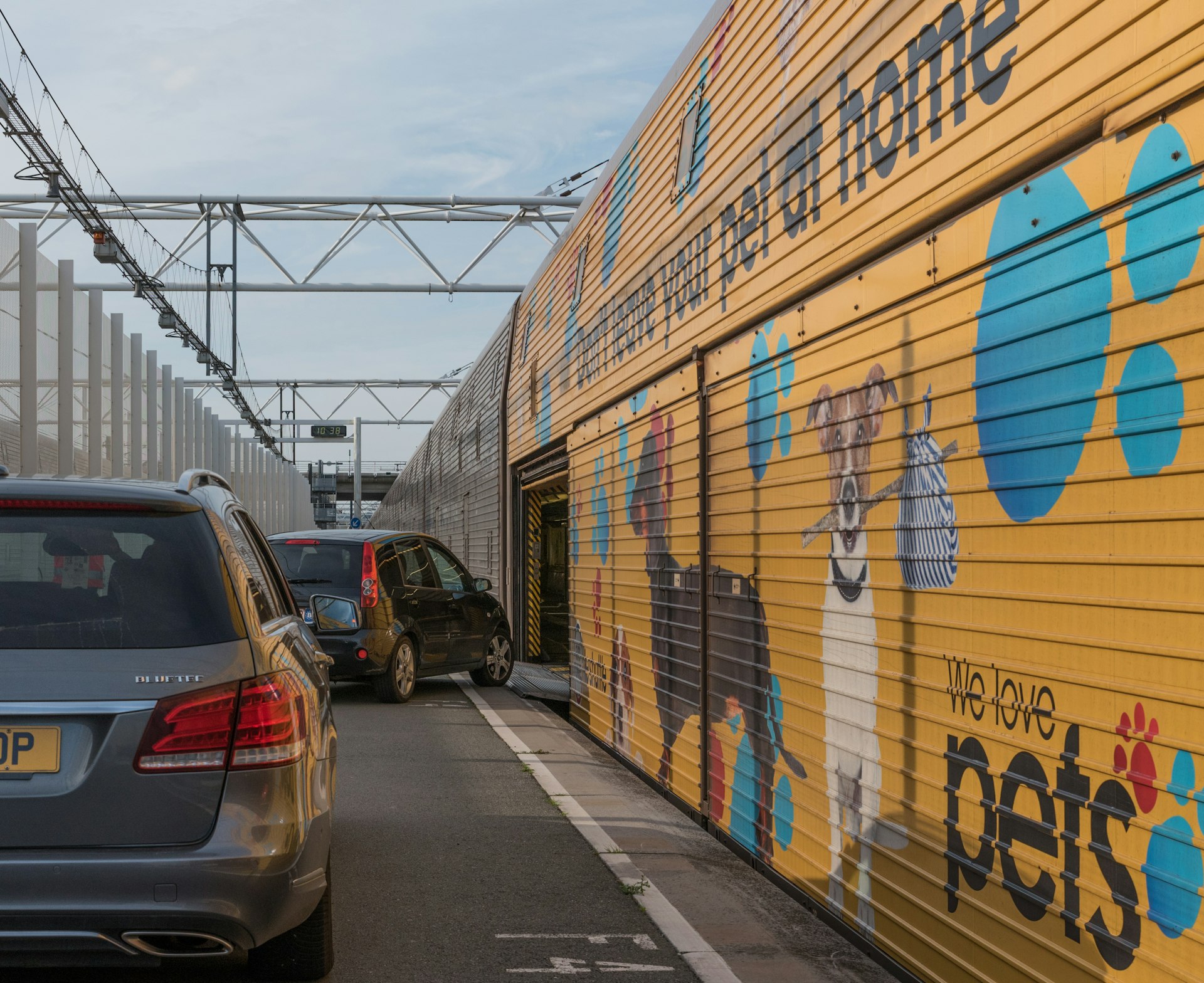
What is the Eurotunnel and where does it go?
The Eurotunnel, or LeShuttle, is a train that carries vehicles and travels under the English Channel, going between Folkestone in Kent , just off the M20, to Coquelles near Calais in France, on the A16 and near the A26. It serves vehicles only – no foot passengers are allowed on board.
How does it compare with the ferry?
Both services give the convenience of being able to take multiple passengers for the price of one vehicle, and to pack as much luggage as you can fit in the car. Both also allow pets on board.
LeShuttle’s claim to fame is the speed of the crossing. For people heading off on a long drive on the other side of the Channel, that shorter 35-minute journey can be worth the usually more expensive price point. However, if you’re hoping to hop out of your car during the ride to take a stroll or pick up some food, the Eurotunnel is not for you.
Don’t want to drive much further? Here’s our guide to Calais and the nearby Côte d’Opale
Where do I buy tickets?
Book tickets online in advance. You will need to provide “Advance Passenger Information” (API) – name, date of birth, passport details etc – online ahead of travel for everyone riding in your vehicle.
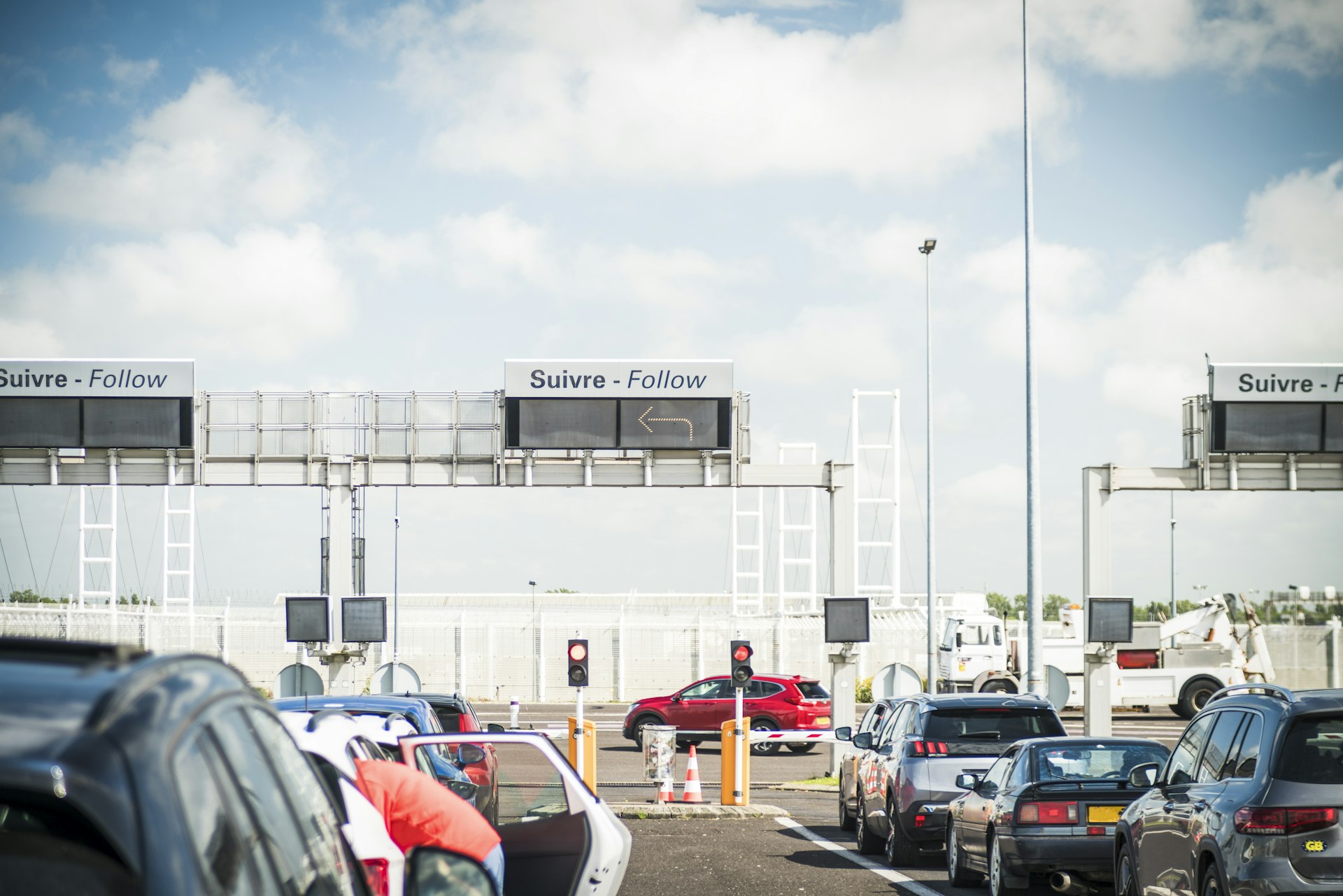
How does it work?
Aim to arrive one to two hours ahead of your booked crossing time. Follow signs off the main roads and onto the Eurotunnel site. Lanes are clearly marked, guiding you to the check-in kiosks. Most kiosks are automatic, but signs will indicate which lanes have staff if you’d prefer to deal with a human. The system uses license plate recognition so, as you pull up at the barrier, your booking will appear on-screen.
Depending on the volume of traffic, you might be offered an earlier crossing time. You have the choice to accept it or stick with your booked train. Unless you’re particularly keen to hang around at the terminal, I recommend taking that gift.
A letter or letter/number combo is assigned to your car and printed out on a piece of paper. Tear it at the top so that it’s shaped like a hanger and hang it from your rear-view mirror so that Eurotunnel staff can see it as you approach them. If your crossing is imminent, staff may wave you straight through, bypassing the terminals. If they don’t, park up and keep an eye on the large screens in the parking lot and within the terminal – they show when you’re likely to be called forward.
Top tip: In Calais, don’t be surprised to be sent on a detour! You may find yourself following signs that appear to be taking you off site. This is a simply a way to manage traffic and you will be directed to check in as soon as possible.
First time visiting France? Here’s what you should know
What happens if I arrive late?
Usually, if you’re late you will be bumped onto the next available service, which might mean hanging around the terminal until the very end of the day. In some cases, you might be asked to buy a new ticket.
What’s in each terminus?
Don’t expect much. Both terminals have restrooms and water fountains, a couple of fast food restaurants and cafes, a newsagent and a relatively small duty-free shop. There’s a little play area for kids too.
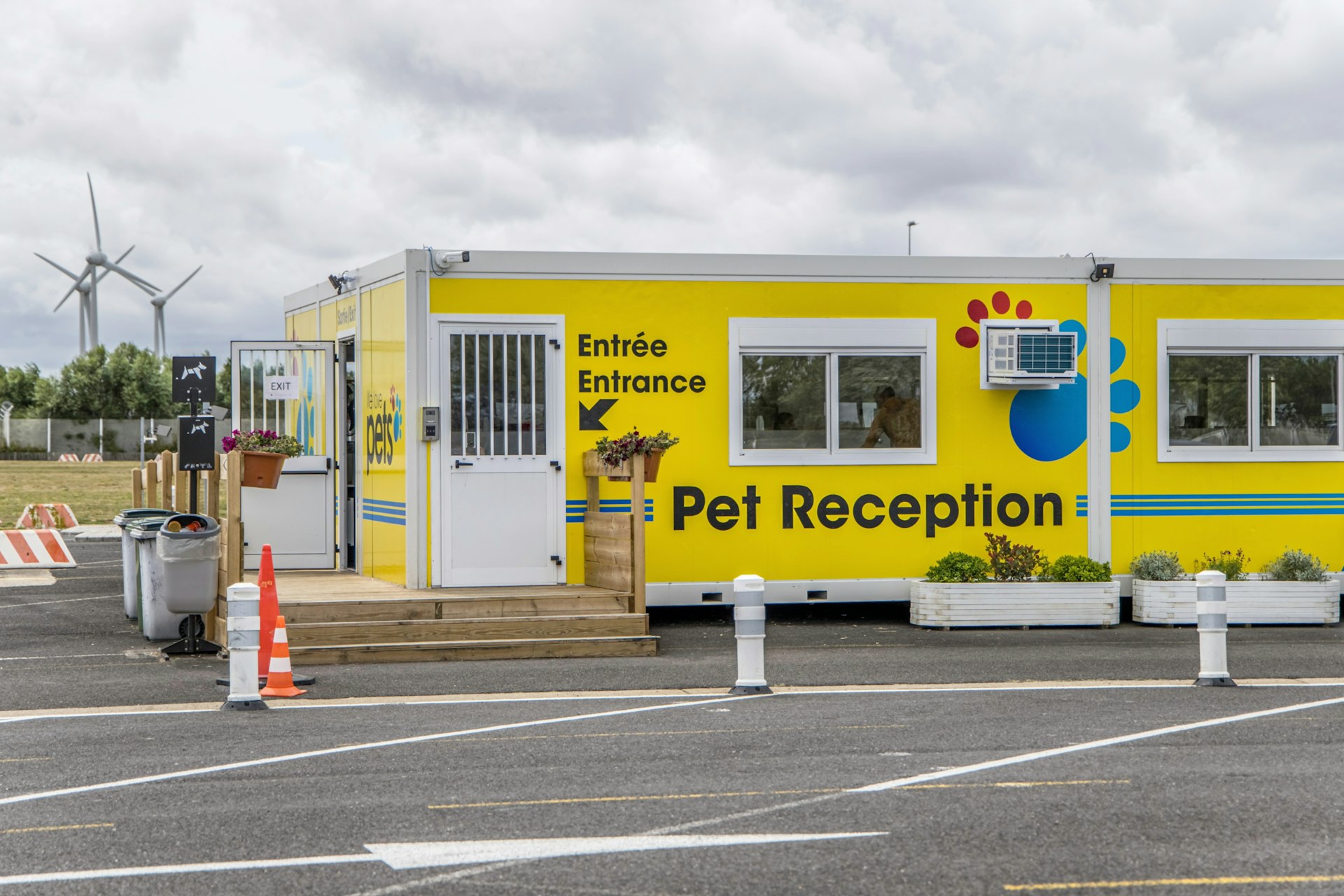
What if I’m traveling with pets?
Traveling with animals requires a bit more planning. Anyone with cats, dogs or ferrets must stop and visit the Pet Reception . The animal must be microchipped and carry an Animal Health Certificate or EU Pet Passport, and dogs must have had tapeworm treatment in advance. There is a dedicated exercise area for dogs near the Pet Reception.
If you’re traveling with rabbits, rodents or reptiles, you must show a certificate that has been approved by a vet to border control.
When do passports get checked?
Once your assigned letter is called, drive on to passport control. Sometimes this is a very smooth process; other times, you might be waiting for hours, shuffling forward one car at a time. You pass through both the UK and French borders at this point – there are no further immigration checks upon arrival.
What about security checks?
Cars are randomly selected for security checks after passport control and you may be asked to pull over while an inspection takes place, including swabbing your steering wheel.
How do you board the train?
Once passports and security are cleared, you are essentially in one massive queue waiting to board a train. You will be allocated a lane to wait in, and you could be sitting there a while. There are toilets here, a few vending machines and an information screen. When a train is ready to board (usually 25 minutes before its scheduled departure time), barriers rise at the front of the lanes and cars proceed from there.
Staff will indicate where on the train they want you to board depending on the size of your vehicle. The train has an upper level in places, so you will need to drive up a ramp to board the top deck. Follow the vehicle in front – you might drive through a lot of carriages – and keep on going until staff indicate you should stop. You will be directed to park up bumper to bumper, then asked to put on your handbrake and apply first gear, and leave your window halfway down.
Pro tip: The barriers can seem to open in a somewhat random order in the stacking area. As you see one lane departing, you might be tempted to sneak across. Don’t. Staff will stop you and send you back to the section you’re meant to be in.
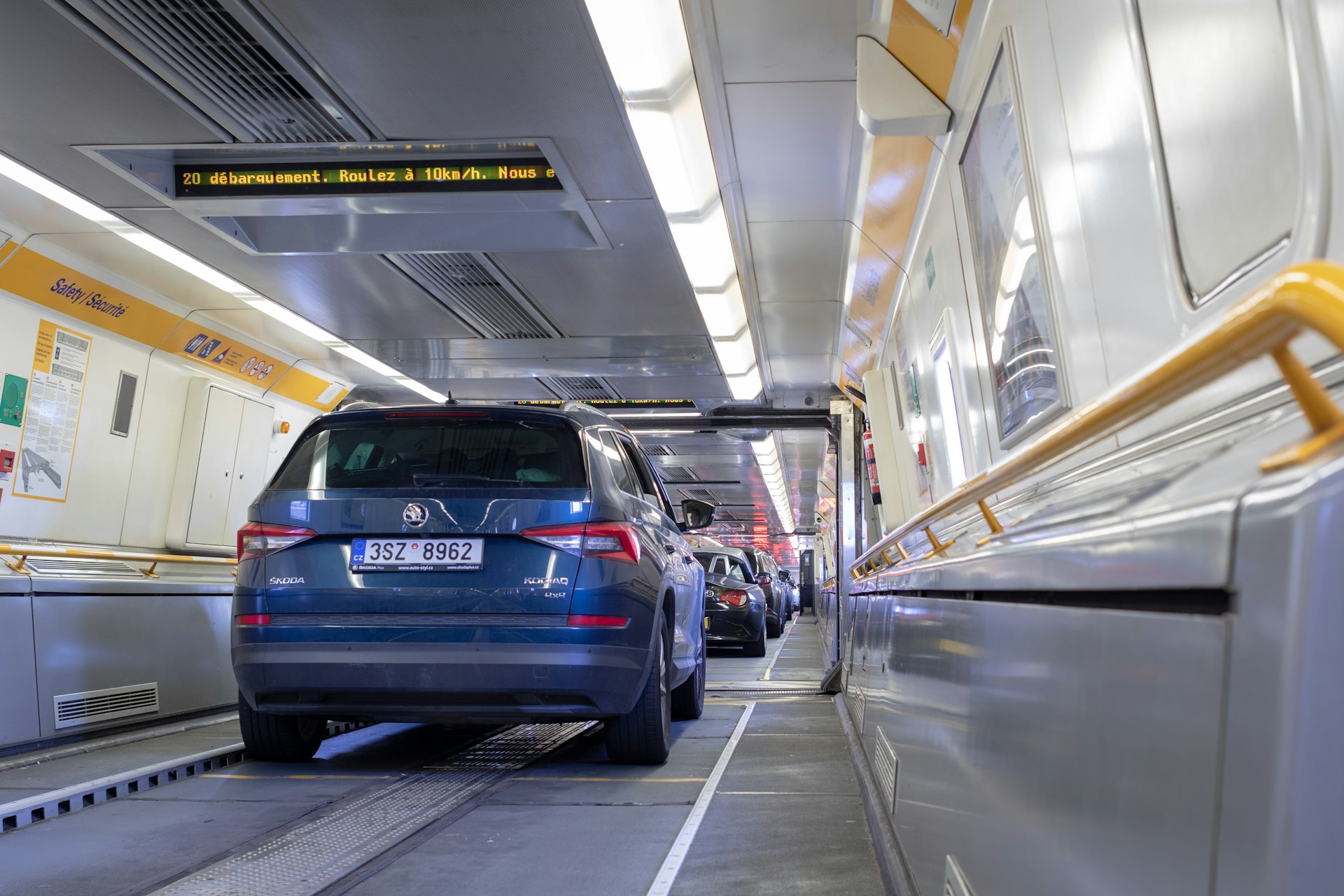
What’s on the train?
Don't get your hopes up for a well-stocked dining car or a gift shop. Even a working toilet is a bit of a stretch on some crossings. Expect bare-bones carriages, with four to five vehicles in each section, and literally nothing else.
Following departure, there are various safety announcements and a member of the train crew will pass through carriages scanning hangers. You’re free to move around outside your vehicle, but there’s really nowhere to go.
What happens on arrival?
As the train approaches its destination, you will be asked to return to your vehicle. Internal doors will open but don’t start your engine until the cars in front of you are on the move so you don’t pump the carriage full of exhaust fumes.
Drive straight off the train and head for the motorways – your road trip has begun.
Keep planning your trip:
- Discover the best road-tripping routes in England
- These road trips in France will take you to all the country's highlights
- Plan the best time to visit France for your perfect vacation
- Find out when is best to visit England
Explore related stories

Tips & Advice
May 29, 2024 • 4 min read
We asked three travel writers about their favorite under-the-radar vacation destinations. Break away from the crowd at these local holiday spots.

May 18, 2024 • 7 min read

May 14, 2024 • 10 min read
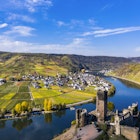
May 9, 2024 • 6 min read

May 7, 2024 • 6 min read

May 7, 2024 • 5 min read
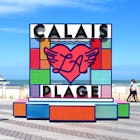
Apr 21, 2024 • 9 min read

Apr 19, 2024 • 8 min read

Apr 17, 2024 • 6 min read

Apr 3, 2024 • 15 min read
- INDUCTION STOVES
- SOLAR PANELS
- CIRCULAR ECONOMY
- IN THE NEWS
Passenger shows benefits of riding one of the fastest trains in the world: 'It's much cheaper than a flight'
"Don't be afraid of public transportation."
- Link Copied!

Photo Credit: TikTok
An American travel influencer recently hitched a ride on one of the fastest trains in France and couldn't help but rave about the experience online.
TikToker Elliott (@callmebelly) posted about their experience traveling on the TGV from Paris to the south of France. The post showcases the speed, convenience, and luxury of the train and makes it obvious to American users that a better transit future is possible.
@callmebelly TGV high speed train is also electric ♻️ #tgv #france #highspeedtrain #europe #trains #traveltiktok ♬ Mozart Turkish March (1120879) - arachang
According to the High Speed Rail Alliance , the TGV is the fastest train in the world, reaching a test speed of 357.2 miles per hour in a modified test environment. From the content mentioned above, it is evident that it also provides an experience that is comfortable, convenient, and affordable.
The TGV is powered by electricity and holds nearly 400 seats. It covers distances which would be considered a long car ride or a short flight in the U.S. However, the high-speed rail covers this trip more efficiently, faster, and at a lesser cost to the environment.
In the United States, fledgling high-speed rail projects are underway. Recently, the U.S. government announced significant investment and broke ground on a rail project running the well-traveled route between Los Angeles and Las Vegas, and the Biden administration has announced support for a 90-minute connection between Houston and Dallas.
Such electric inter-city projects are the perfect environment for a high-speed rail network and offer benefits such as reduced traffic congestion , low-pollution electric travel , and convenient travel .
Watch now: Solar-powered boats from the Honnold Foundation are making a difference in the Amazon
The benefit of getting travelers out of gas cars and on to electric trains could also be immense for the environment. Rail systems like the TGV can run on third rails or overhead wires that power the trains through electricity, making for long range, zero pollution, and fast travel.
As Elliott noted, "It's much cheaper than a flight."
🗣️ Would you want a high-speed railway in your state?
🗳️ click your choice to see results and speak your mind.
Users in the comments of the post shared positive experiences and a yearning for similar systems in the United States.
One user commented, "Rode it from Basel to Paris! Favorite transport."
Another joked, "Don't be afraid of public transportation. Such an American moment. But that's okay. Good video mate."

Join our free newsletter for weekly updates on the coolest innovations improving our lives and saving our planet .

Here are 5 innovative design ideas that can protect homes during the most extreme weather disasters

This new law is like a free '$8,000 bank account' for remodeling your home — here's how to take advantage of it

Here's a simple way to turn your old sneakers into actual cash: 'I can tell you firsthand — it works'

Induction stoves can be a total game-changer in the kitchen — and these ultra-efficient gadgets prove it


COMMENTS
Paris to Nice, Lyon or Bordeaux from €25. The best way to travel between French town & cities is by train, in comfort at ground level. France's world-famous TGV travels at up to 199 mph, from city centre to city centre, and if you pre-book direct with the operator you can find some really cheap fares, too.
TGV, the high-speed rail service which links together the major cities of France like Lyon, Bordeaux and Marseille. With TGV, you can go to more than 230 destinations in France and Europe. If you want to learn more about TGV routes and other fast trains across the continent, visit our high-speed trains in Europe page.
The TGV Train network (Train a Grande Vitesse) runs to major cities in France and Europe.; Intercites trains cover many of the medium distance routes between cities like Amiens, Orleans, Bordeaux, Caen, Lyon, Reims, Troyes, Toulouse, and Paris. They link cities in French regions like Nantes, Bordeaux, and Lyons-Nantes-Tours. TER is the French regional service running from towns and villages ...
Expert tips for train travel in France. 1. Buy tickets early for the best price and availability. If you're looking to travel by train and know your plans well in advance, it pays to buy the tickets well in advance. You'll get the best price. Another reason why you'll want to book early whenever possible is because trains in France sell ...
Tips for train travel in France. Train options in France. Several different types of trains travel across France, including local and regional trains, overnight trains with sleeping accommodations and the TGV, the high-speed Trains à Grande Vitesse. To travel between most big cities, the TGV is your best bet: these pioneering high-speed trains ...
Download the SNCF Connect app for faster, easier and cleaner mobility across France. With one touch, you can organise, book and manage your day-to-day trips as well as long-distance trips. Travel with peace of mind, and find all the information you need during your trip: e-tickets, real-time timetables, live traffic information...
Train travel in France is an easy, affordable, and sustainable way to get around and see all that the county has to offer. There are over 1700 kilometers of high-speed train lines all over France. One of the best parts about traveling by train is the fact that there are stations in almost every city rather than only near the airports.
If you're planning a trip and want to travel by rail, take a look our train map of France. It highlights some of the most popular routes across the country, including high-speed, regional and the major international routes. Click on each of the routes to find journey times and where to book your tickets. *Routes are subject to change ...
France Itinerary. Discover the best of French life with this spectacular France itinerary. Start your trip in beautiful Paris and let the train carry you down to the sunny Mediterranean, while cruising through hillside vineyards and endless lavender fields. Reserve a seat on France's TGV high-speed train for fast and comfortable journeys ...
TGV, the high-speed rail service which links together the major cities of France like Lyon, Bordeaux and Marseille. With TGV, you can go to more than 230 destinations in France and Europe. If you want to learn more about TGV routes and other fast trains across the continent, visit our high-speed trains in Europe page.
4. TER (Transport Express Regional) TER trains are regional trains in France, usually referred to as local trains. They are ideal for getting between regional French towns and villages. Like long-distance trains, with TER trains, you can also travel first or second class, but this will change soon (a unique class).
In France and Europe, easily book your train journey (TER, Intercités, TGV INOUI, OUIGO or Transilien) and buy your train tickets, passes and season tickets. Updated on 21 December 2023 1-minute read. For all your travel needs in France and Europe, find your tickets here or in one of the 800 agencies approved by SNCF Voyageurs.
TER. OUIGO Grande Vitesse offers low-cost TGV services traveling at over 300 km/h, transporting you to France at a low cost. With OUIGO, you can add numerous options to your train ticket: extra luggage, wifi, power outlets, seat selection, bicycles, and more. The OUIGO Plus offer includes, for an additional 9€ on top of the ticket, an extra ...
The trains available on the site connect most of the major French cities and allow you to easily cross France. With SNCF Connect, travelling to major European cities has never been easier.You will find tickets for numerous European train companies such as Eurostar, TGV Lyria, Thalys or RENFE. This means you can easily travel to the UK, Germany, Italy, Spain or Switzerland.
France 2 Week Itinerary #5: Paris - La Rochelle - Bordeaux - Biarritz. This 2 weeks in France itinerary by train starts from Paris, and it explores some of the most beautiful cities in Western France. Spend 14 days in France, combining sightseeing with relaxing days by the beach.
Yet still, for many visitors, the highlight of train travel in France is exploring rural routes with slower, regional express trains (TER for short) which meander from the likes of Paris to Provence, Lyon to the Loire or Brittany to Bourgogne. France has numerous train stations in major cities and towns.
Paris to Barcelona from US$38.50. Paris to Turin from US$34.50. Barcelona to Paris from US$54.50. Paris to Rome from US$25.80. Paris to Bordeaux from US$11.00. Travelling on a shoestring? Find the best prices for your train travel with TGV. Fast, Easy & Secure booking with raileurope.com. Enjoy Europe by train!
See our further advice on France-Italy trains. Eurostar trains require reservations that cost $25-35 for trains between Paris and Brussels (and points beyond) or $35-$45 between London and France (Paris, Lille, and Disneyland), if traveling with a pass that covers both ends of the route (a Global Pass). These trains have three classes of ...
All France trains are comfortable, modern, punctual, and offer first-class service on board. To be fully prepared for your upcoming adventure, below you can find France train map as well as some useful information about the types of trains operating on the French railway lines. Overall length of rail tracks in France: 29 901 km.
Prepare your journey. Recherchez un itinéraire. Consultez les horaires en gare. Recherchez un numéro de train. Consultez les informations sur le trafic. For all your travel in France and Europe, find your tickets here or in one of the 800 agencies approved by SNCF Voyageurs. Book your tickets here.
A guide to travel by TGV. TGVs or Trains à Grande Vitesse are the pride of SNCF (French Railways), running at up to 300 km/h (186 mph) on a high-speed network linking towns & cities across France. In fact, trains reach 320 km/h (199 mph) on the newer TGV-Est & TGV-Rhin-Rhone routes. Smooth & quiet even at high speed, it's a relaxing way to travel.
Find real-time timetables on the SNCF Connect website or application. Enter a destination, your station and your departure date and select the route that suits you. Amsterdam. departing from Paris. Paris. departing from Amsterdam. Geneva. departing from Paris. Paris.
Hannah Thompson. Published tuesday 04 June 2024 - 15:38. A new €49 rail pass is to go on sale in France tomorrow (June 5) in a bid to encourage more young people to use the train network this summer. The pass, Le Pass Rail, will cost €49 per month for unlimited use on trains across the country, and will be available to everyone aged 16-27.
France's $10 Occitanie Rail Tour Pass is a steal and without a doubt one of the best travel deals this summer. Where Can Travelers Go? The Occitanie region is home to incredible French cities like Montpellier, Nîmes and Toulouse. You may wonder what all these cities have in common. The answer is…wine!
Eurostar trains travel between the U.K., France, Belgium, Netherlands and Germany. (Although the U.K. is not in Europe, it's a popular destination on its own and often coupled with a European ...
Young people will be able to travel the length and breadth of mainland France in July and/or August for a flat fare of €49 (£42), which works out at £1.35 per day. They will need an address in ...
In May 1994, the Eurotunnel - linking England and France under the English Channel - was opened in a ceremony led by French President François Mitterrand and Queen Elizabeth II. In the 30 years since then, the network, which shares its tunnel with the Eurostar service, has carried nearly 10 million passengers per year between England and mainland Europe.
Book your train tickets to France and Europe at the best price and plan your route on SNCF Connect: TGV INOUI, Eurostar, Ouigo, ... Travel by train. There are 2,000,000 TGV INOUI tickets available for less than €49 (VAT included) as of May 28, 2024. Price per traveler, for a one-way journey without connections, on certain days and in certain ...
@callmebelly TGV high speed train is also electric ♻️ #tgv #france #highspeedtrain #europe #trains #traveltiktok ♬ Mozart Turkish March (1120879) - arachang. According to the High Speed Rail Alliance, the TGV is the fastest train in the world, reaching a test speed of 357.2 miles per hour in a modified test environment.From the content mentioned above, it is evident that it also provides ...
There is a new perfume out on the market, which translates to "Travel to France" by Fragrance Du Bois, which is made in Paris, and it just might offer you that sensory trip to The City of Light.